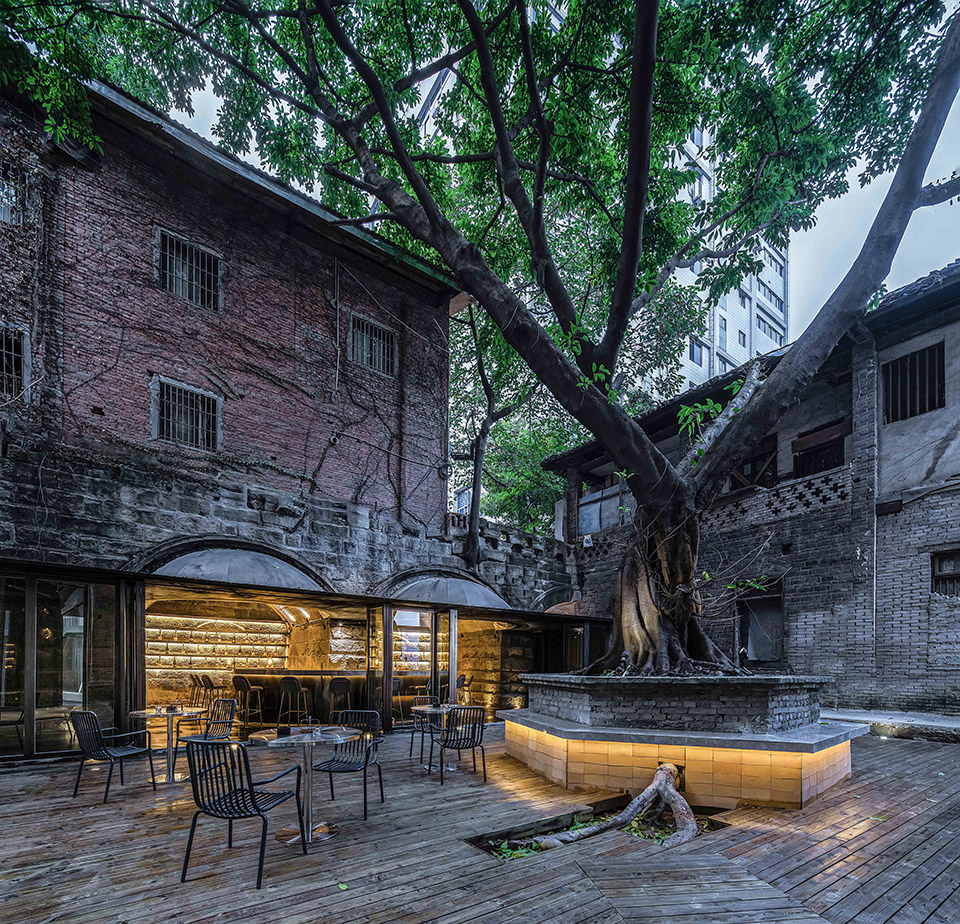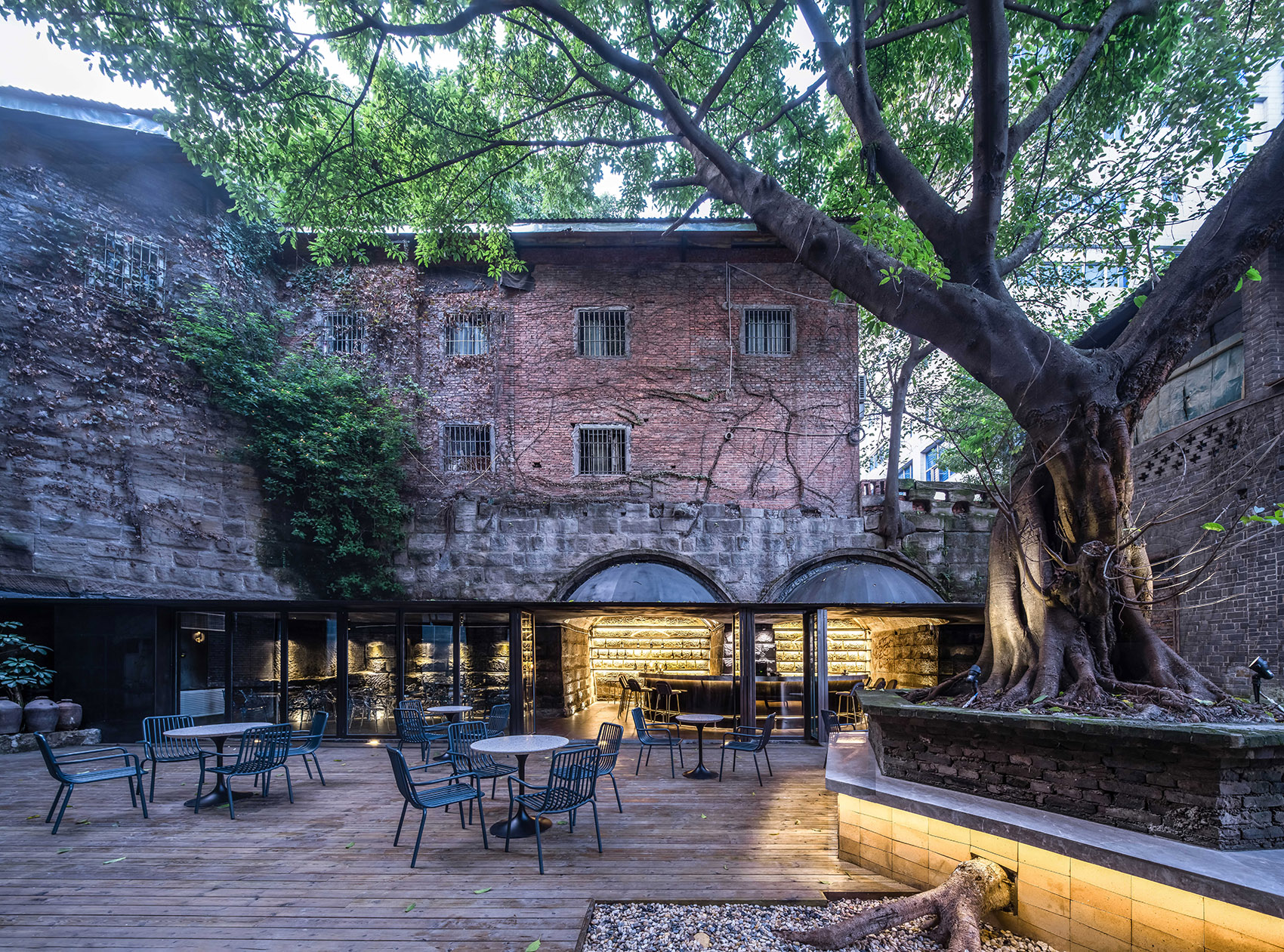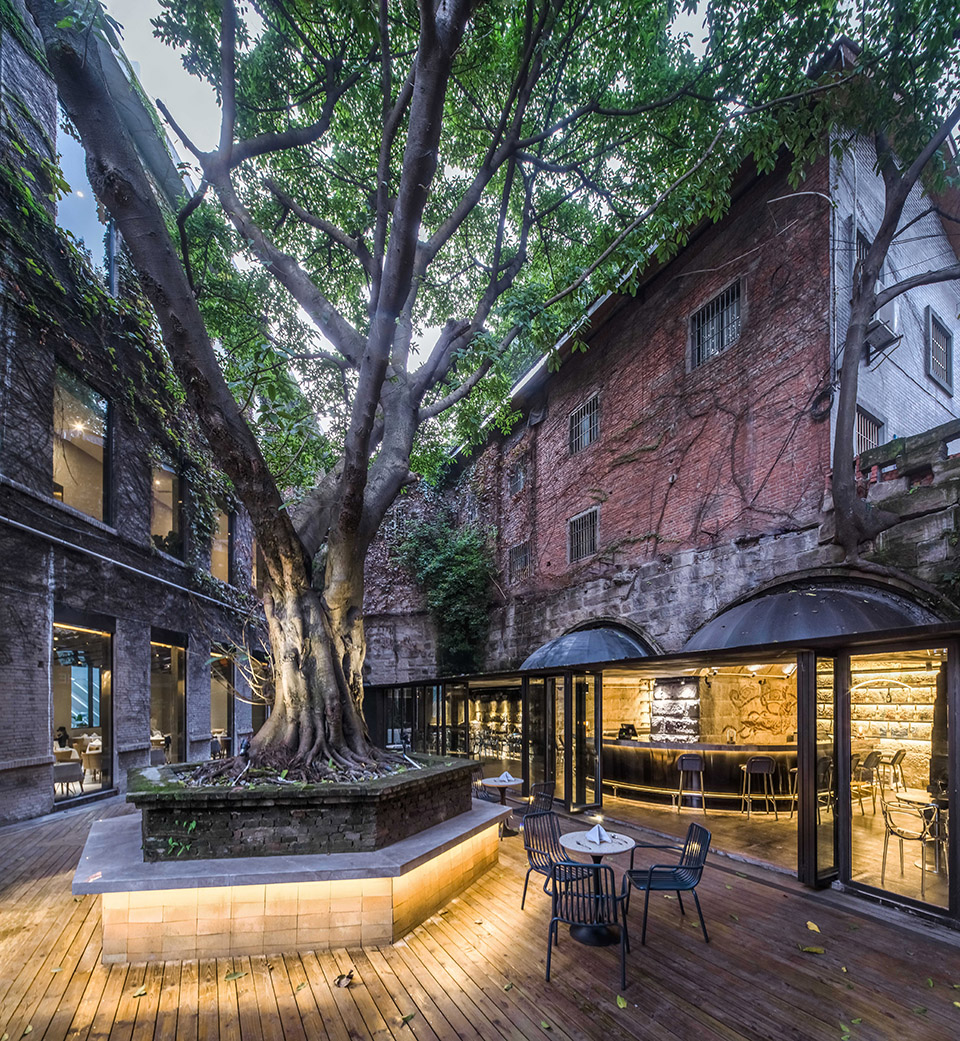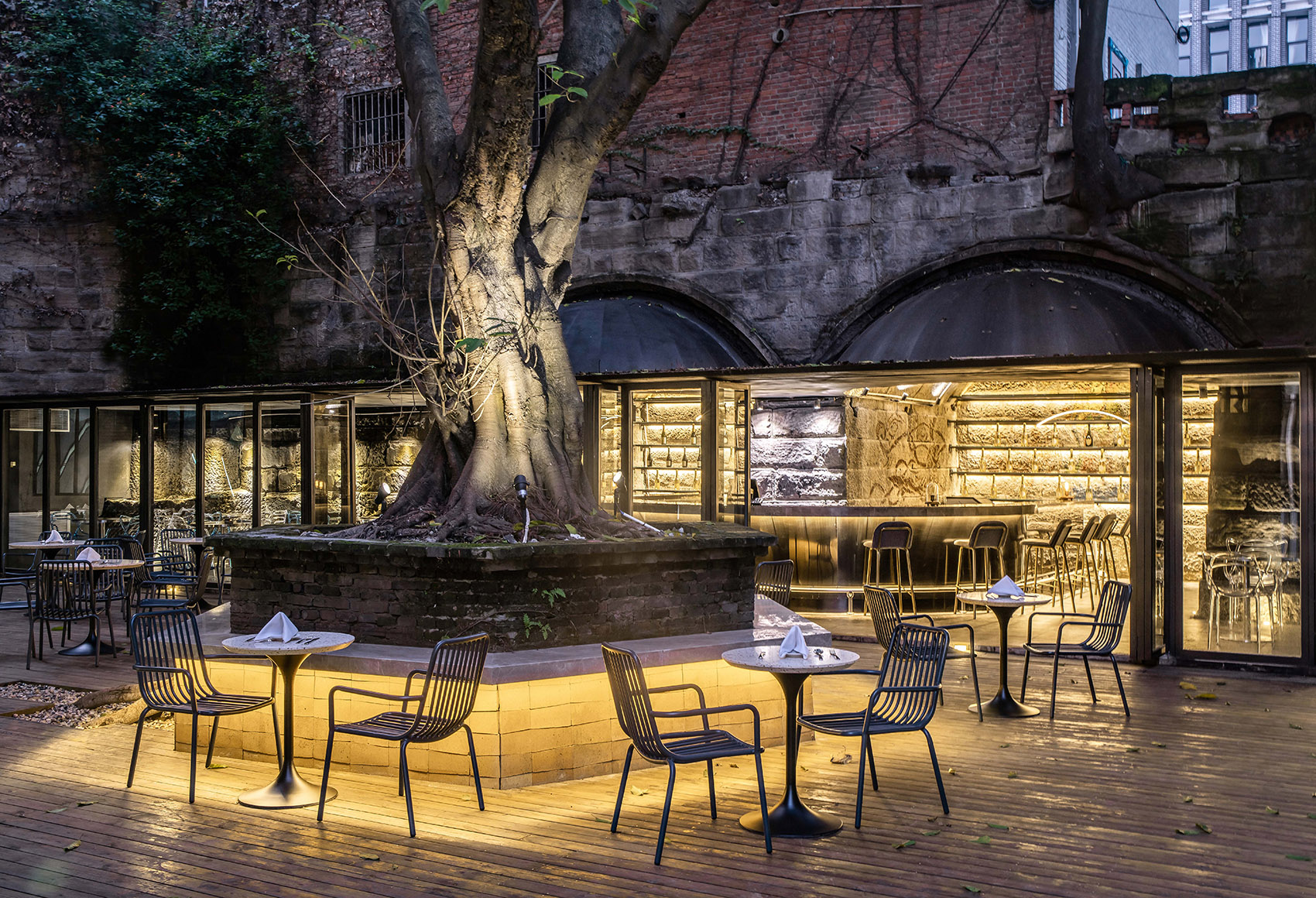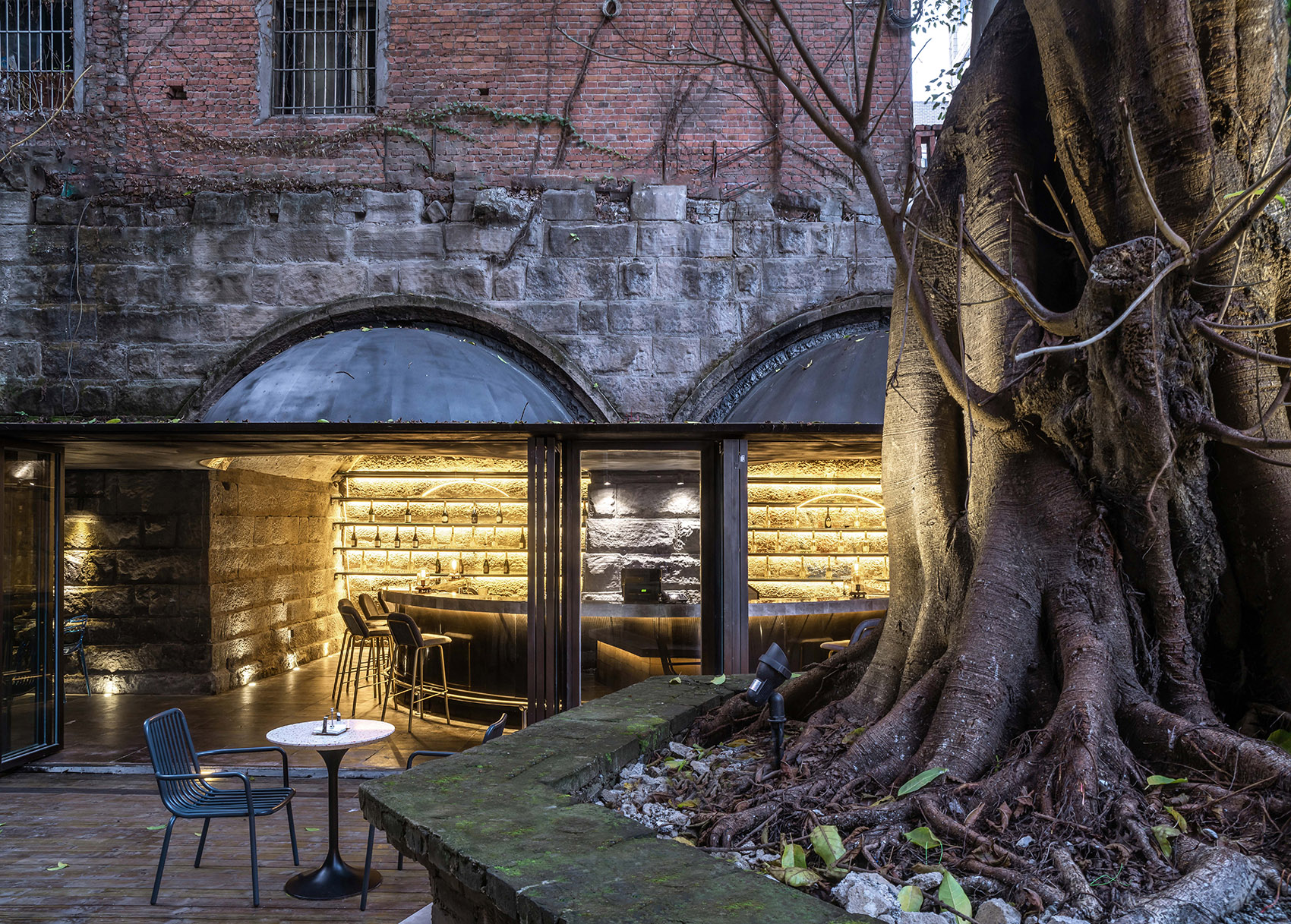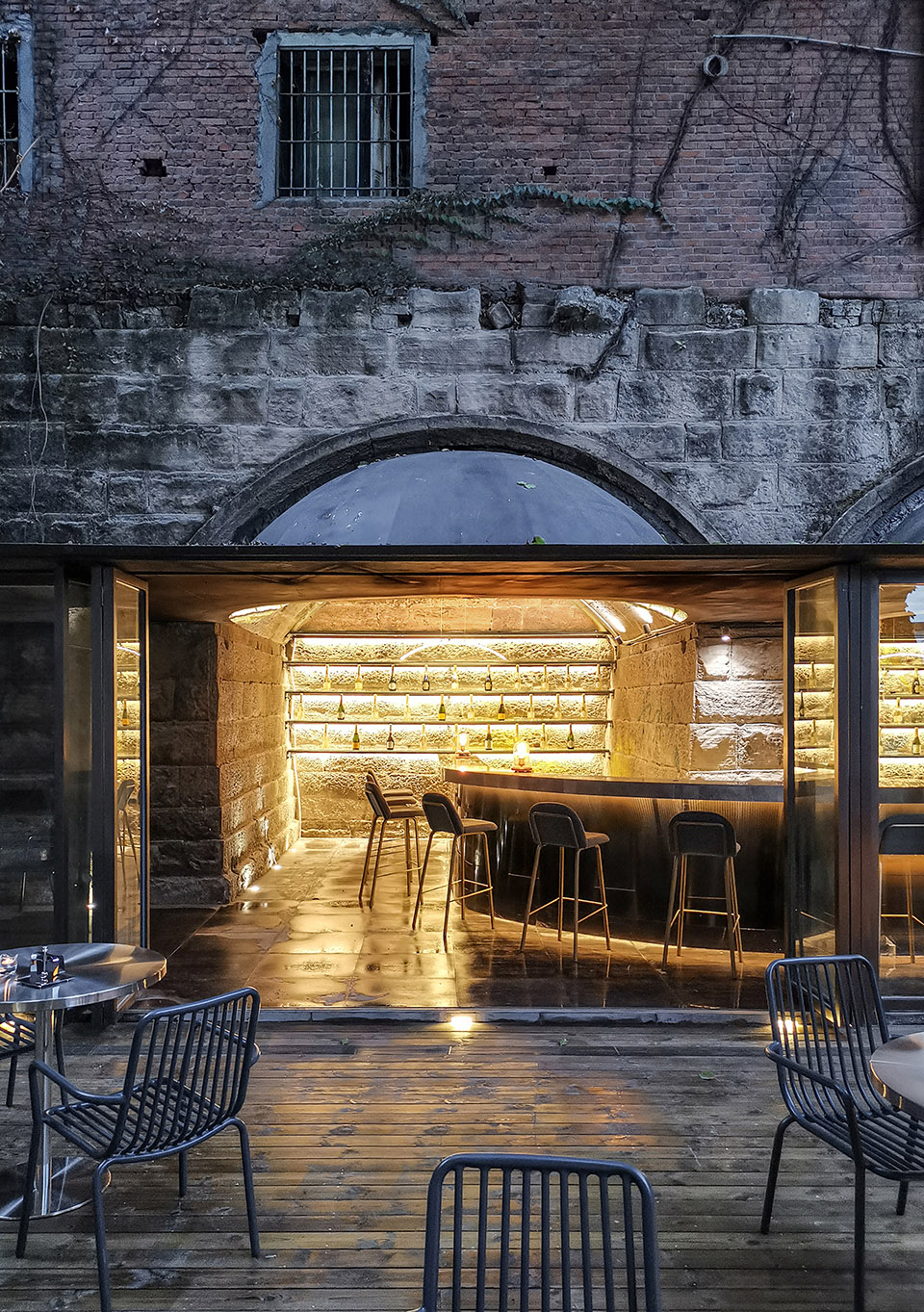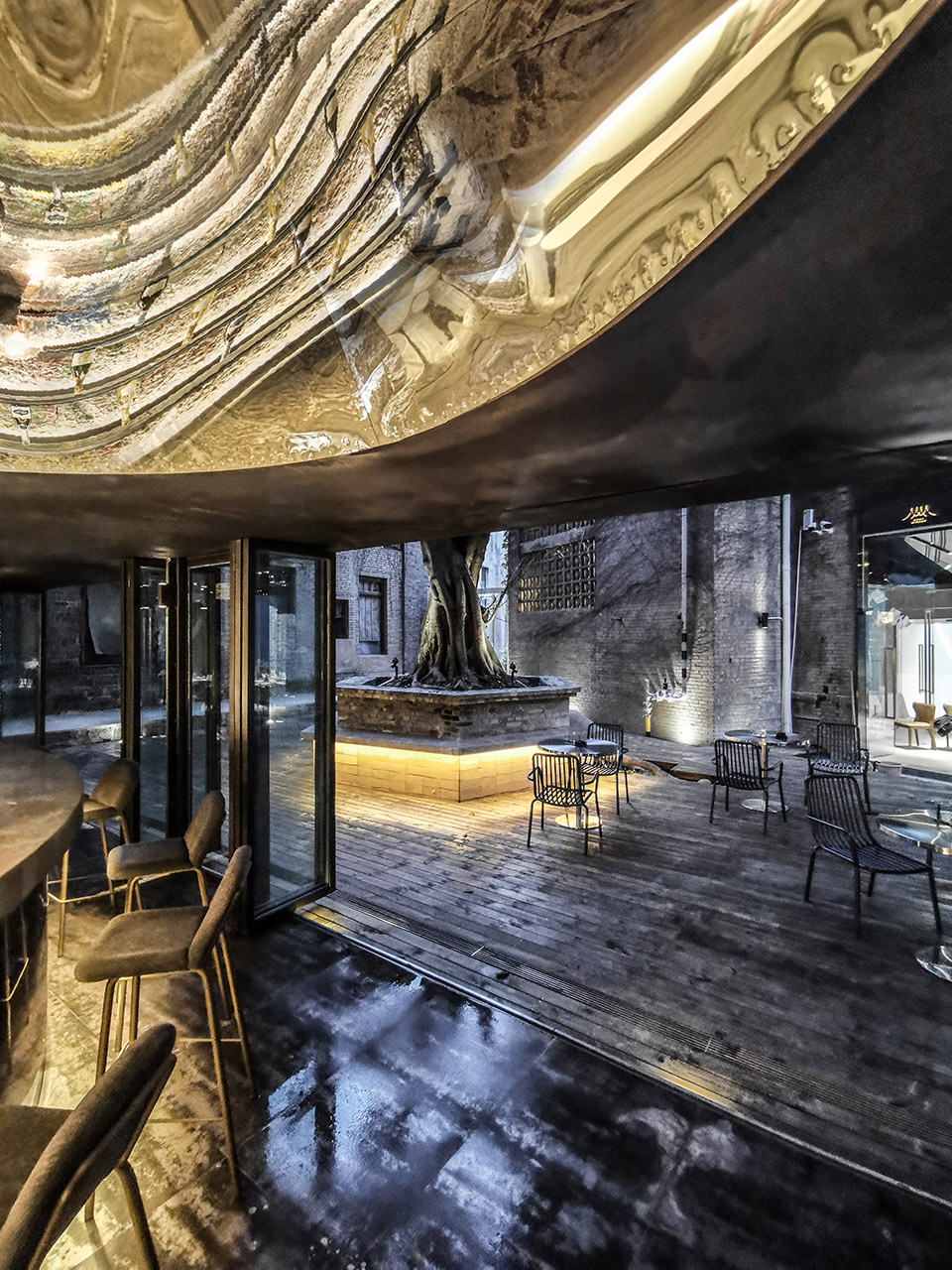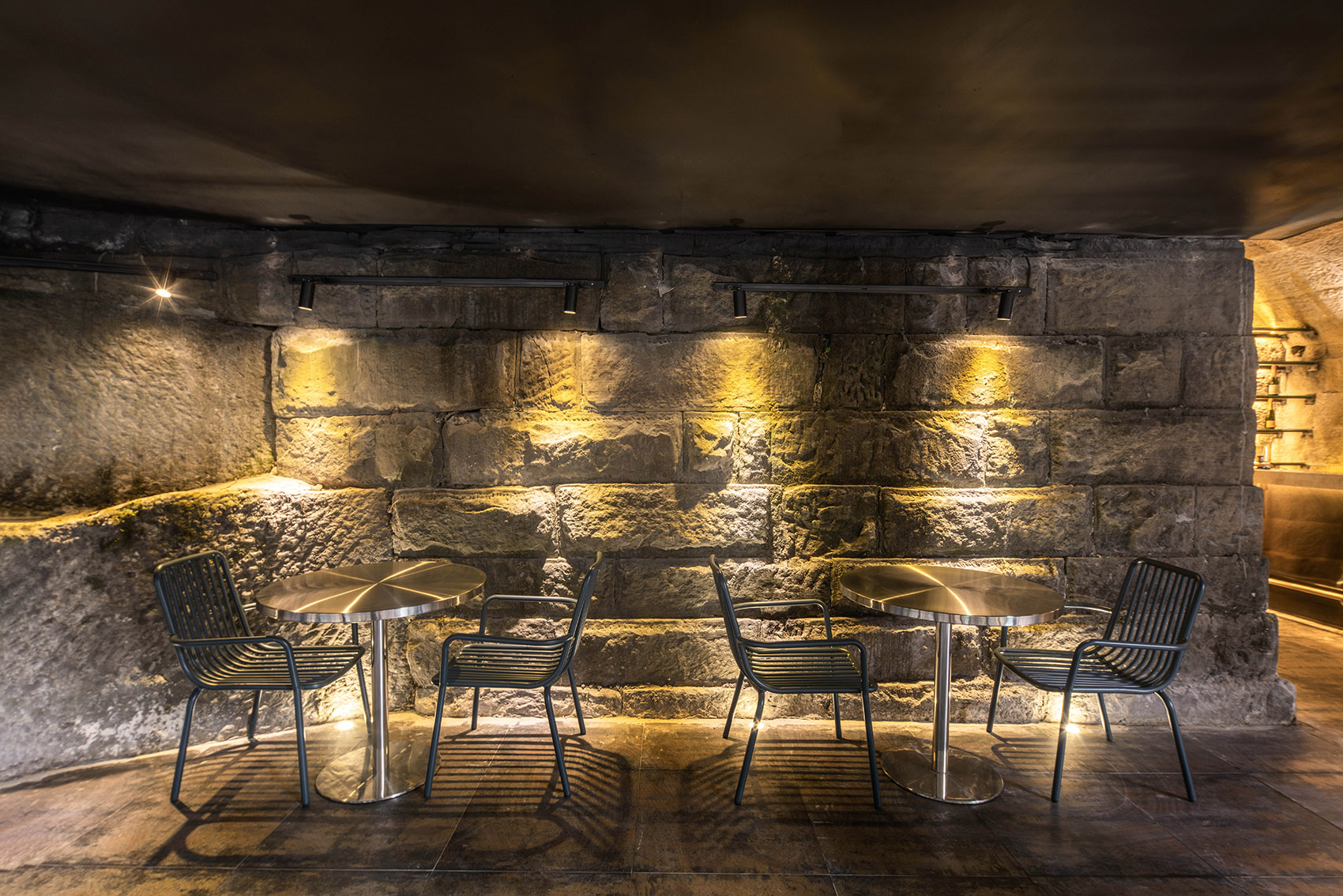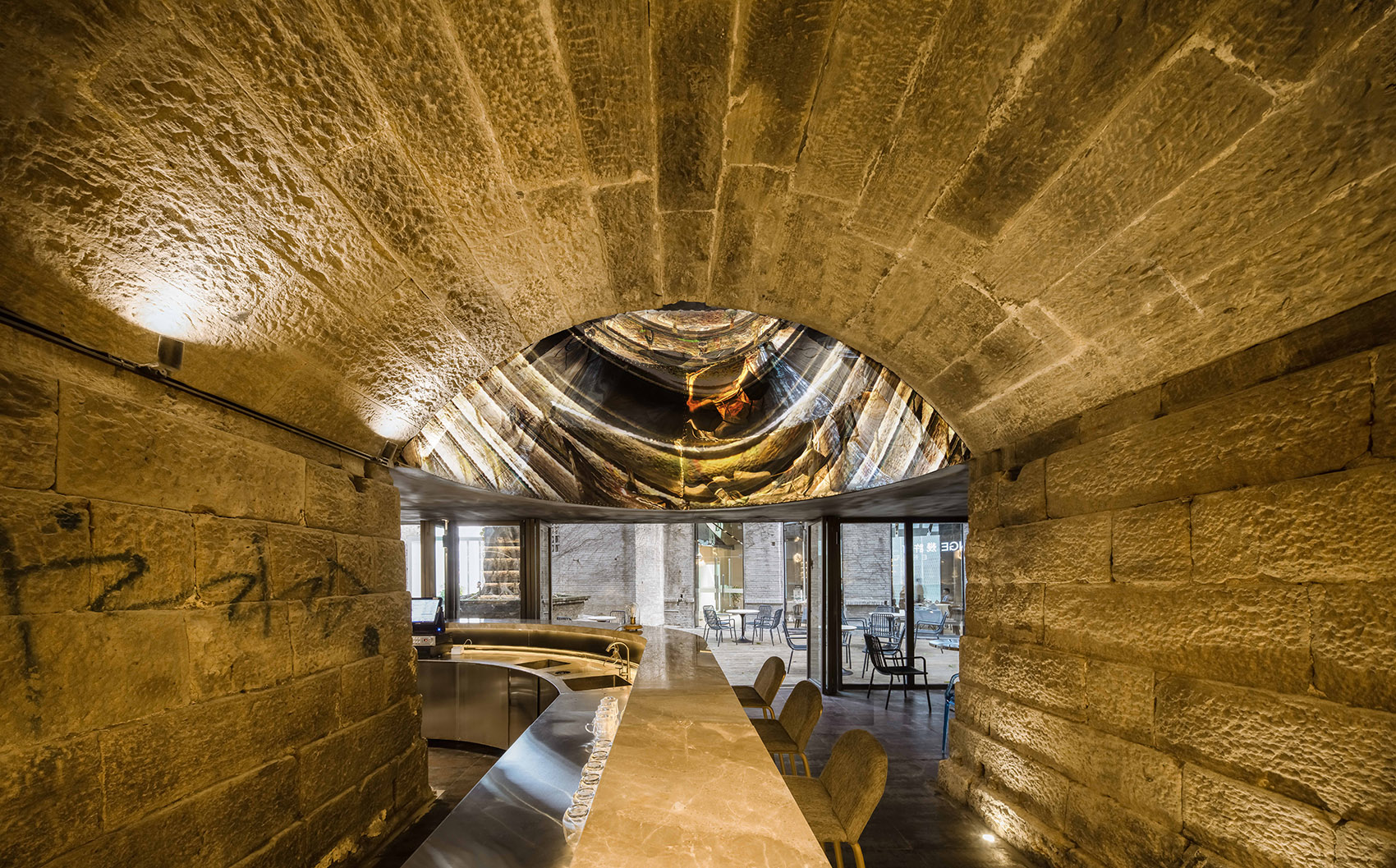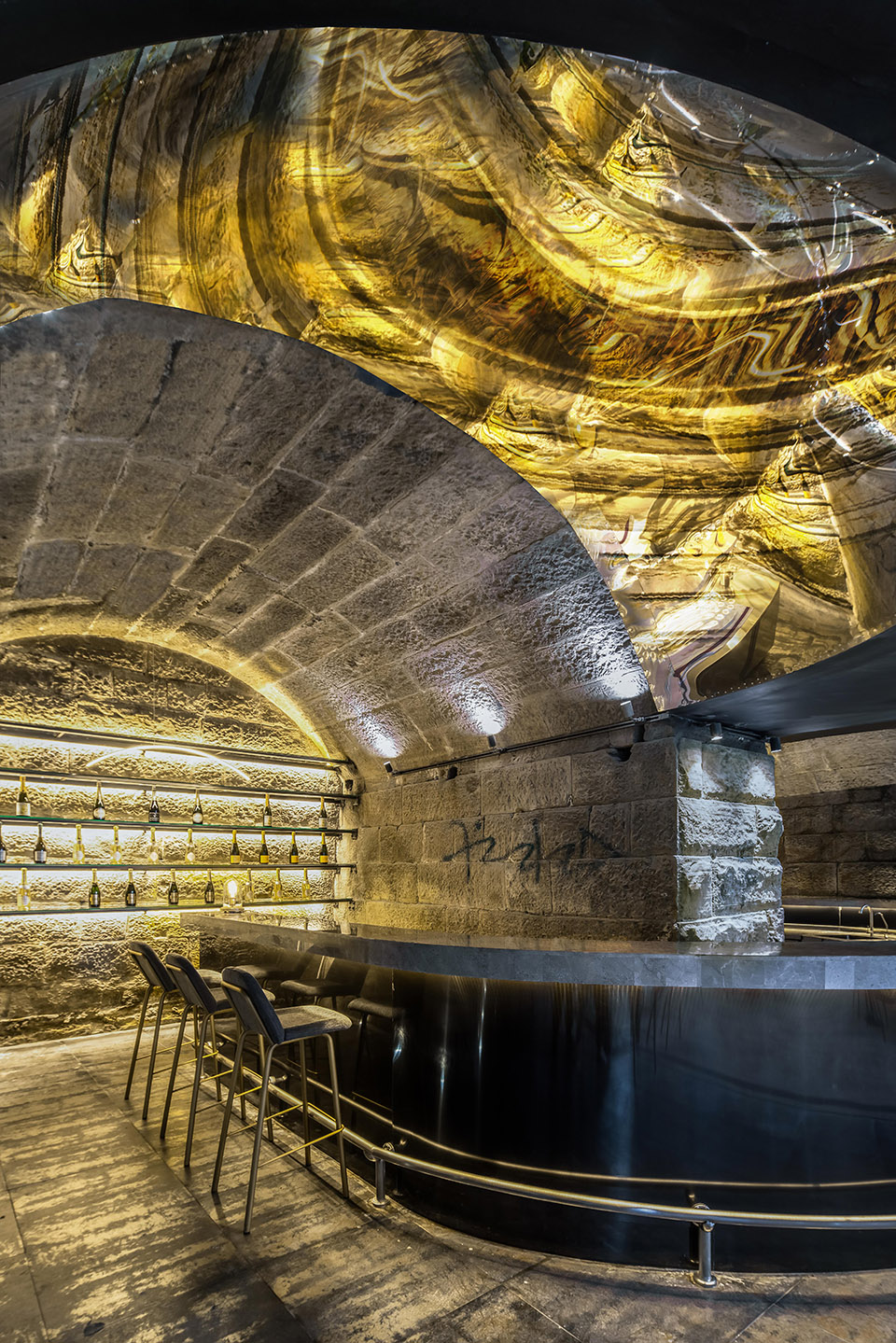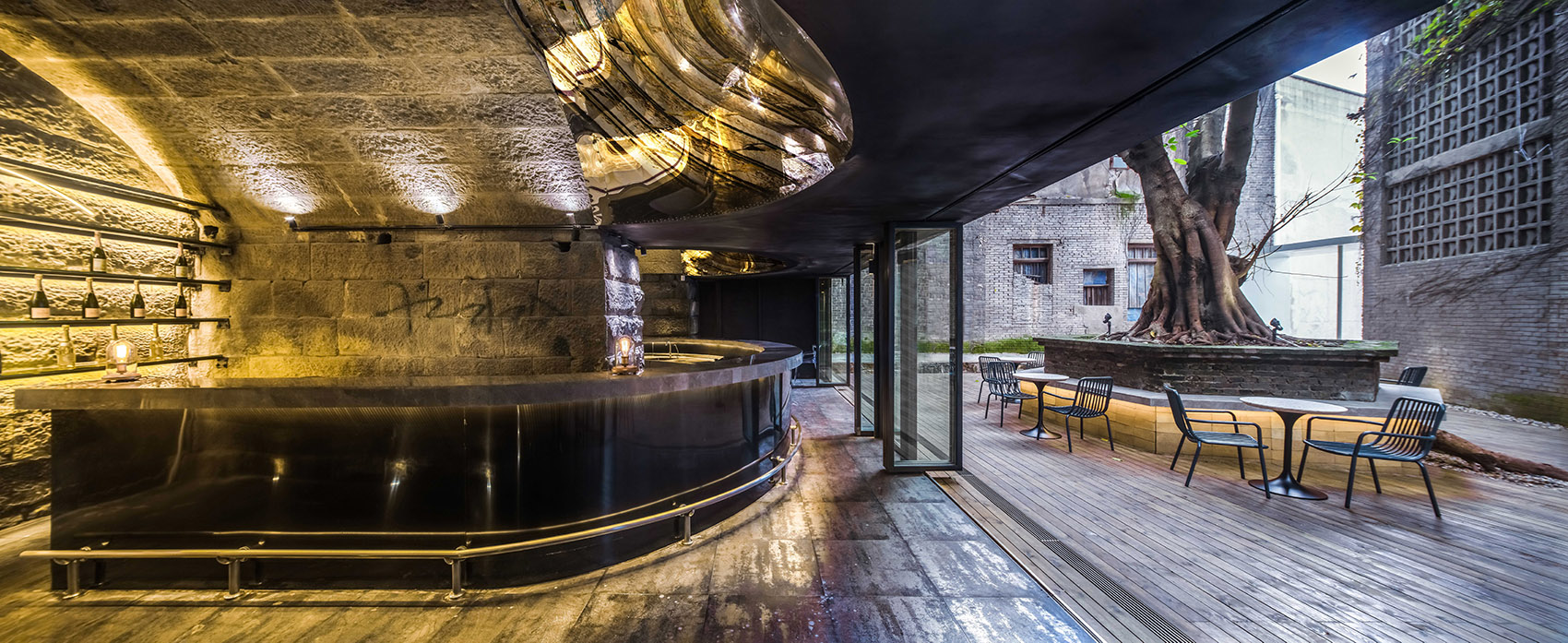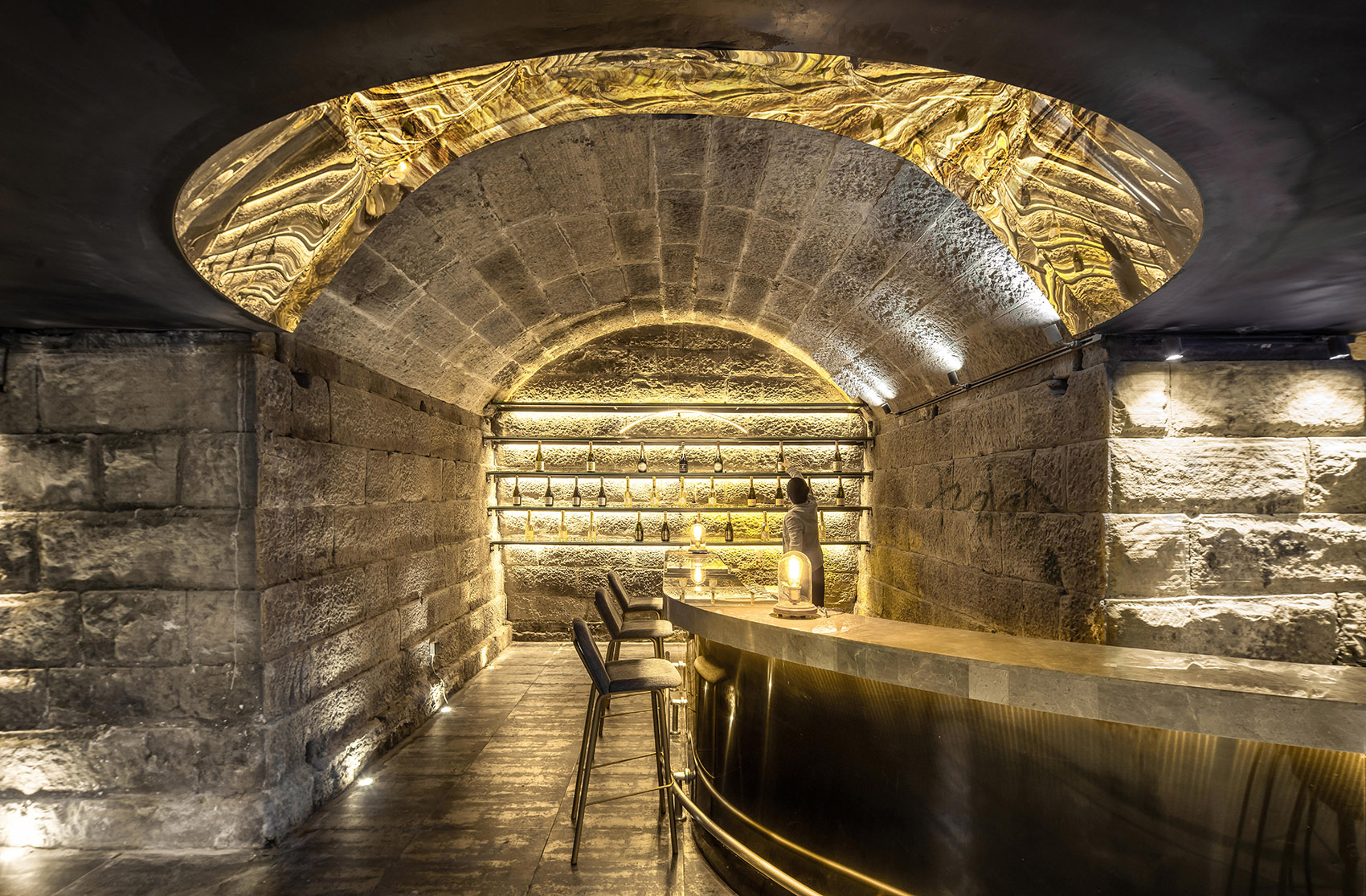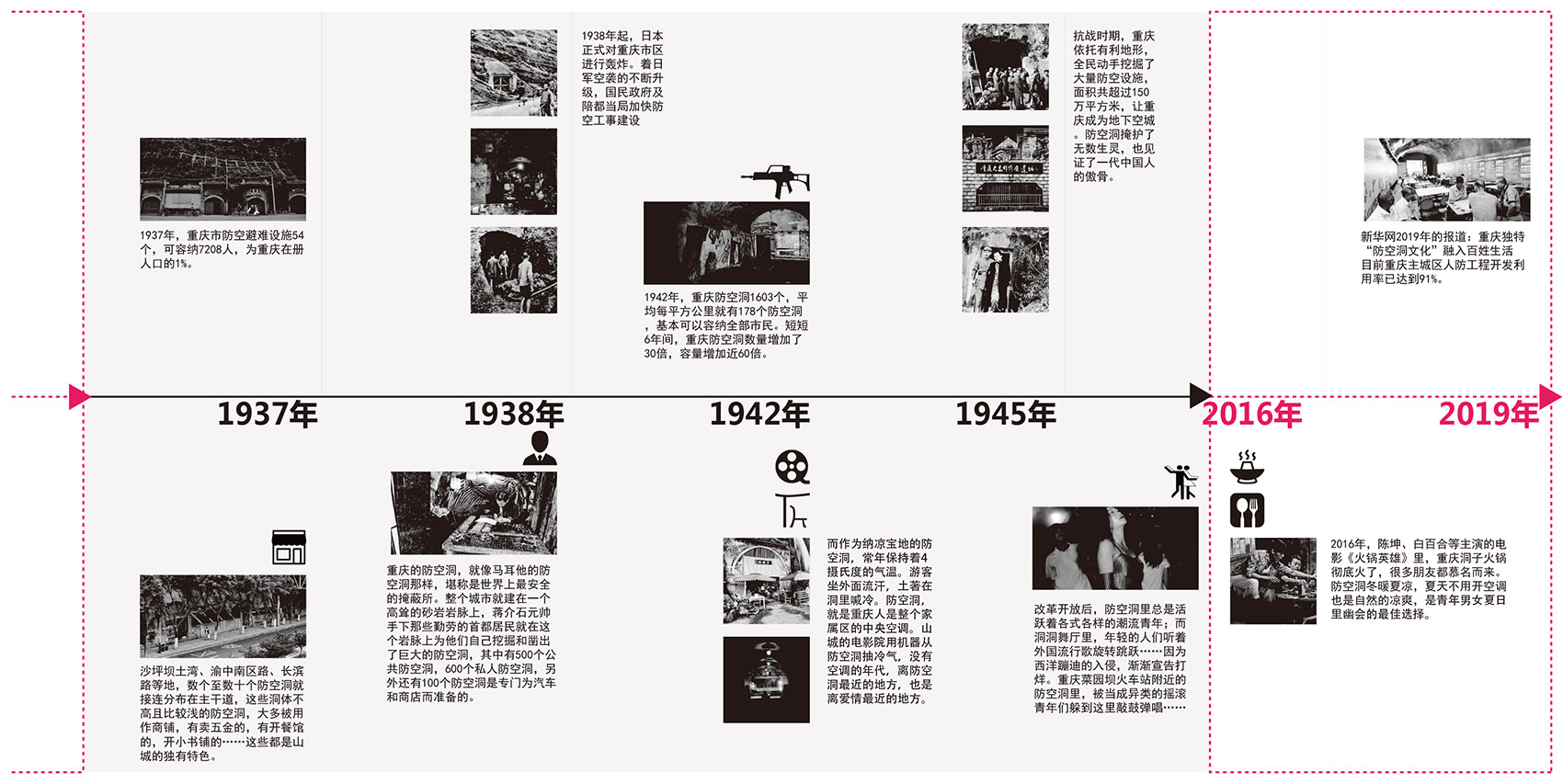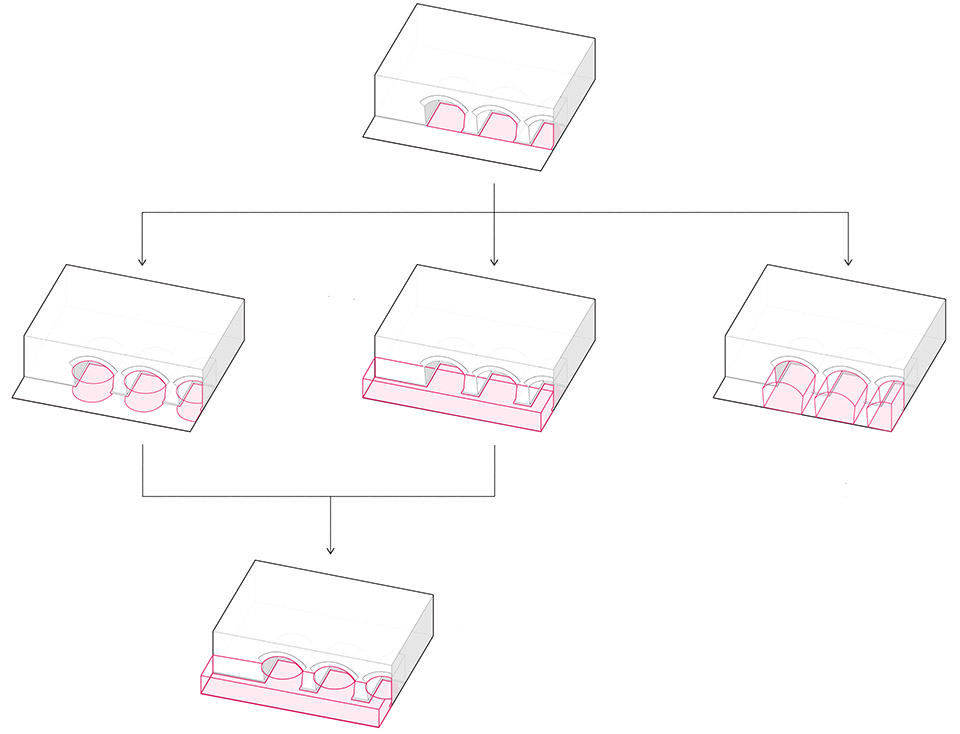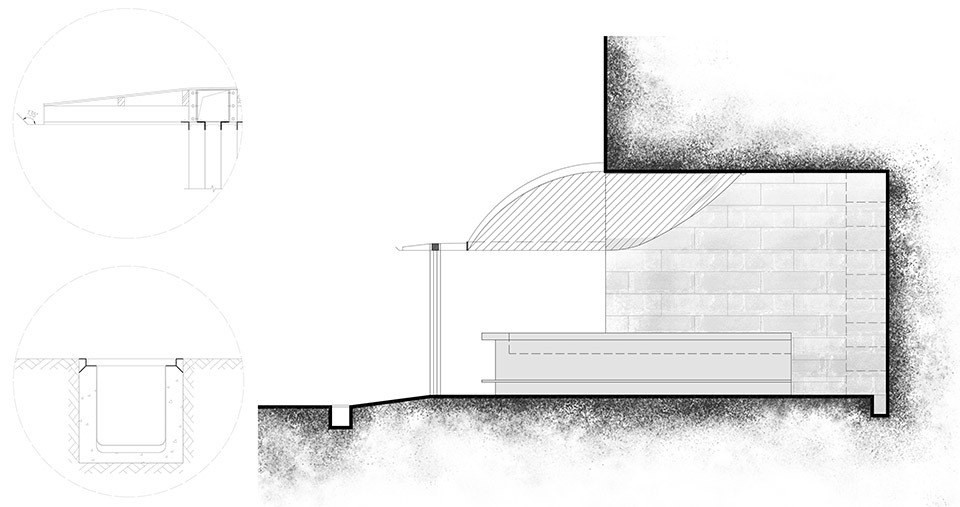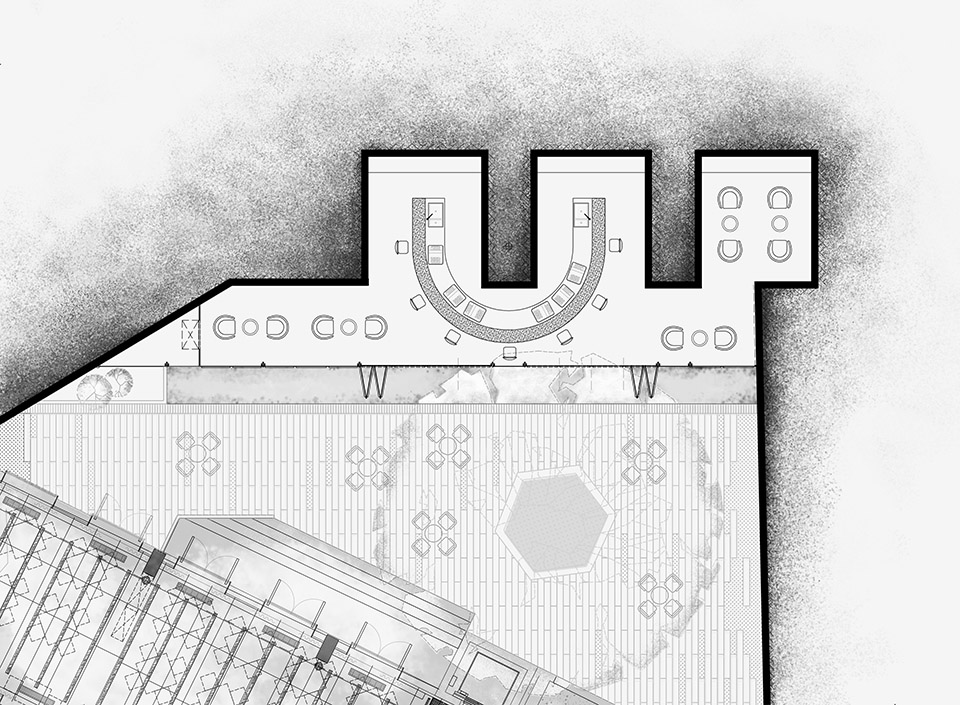“重庆,是一座布满防空洞的城市 … 上上下下,密密麻麻,到处都是 … 当火锅跟防空洞结合的时候,就产生了重庆最大的特色 … ”杨庆导演2016年的电影《火锅英雄》给我们刻画了“洞子火锅”这一奇观式的餐饮空间。抗战期间,重庆军民挖掘了当时世界上最庞大的防空工程网,面积超过150万平方米。据陪都防空司令部的统计档案显示:1937年,重庆市共有防空避难设施54个,可容纳7208人,仅占重庆在册人口的1%。从1938年起,日本正式对重庆市区进行轰炸,国民政府随之加快防空工事的建设。至1942年,重庆防空洞数量已达1603个,平均每平方公里就有178个防空洞,基本可以容纳全部市民。
▼项目概览,overview
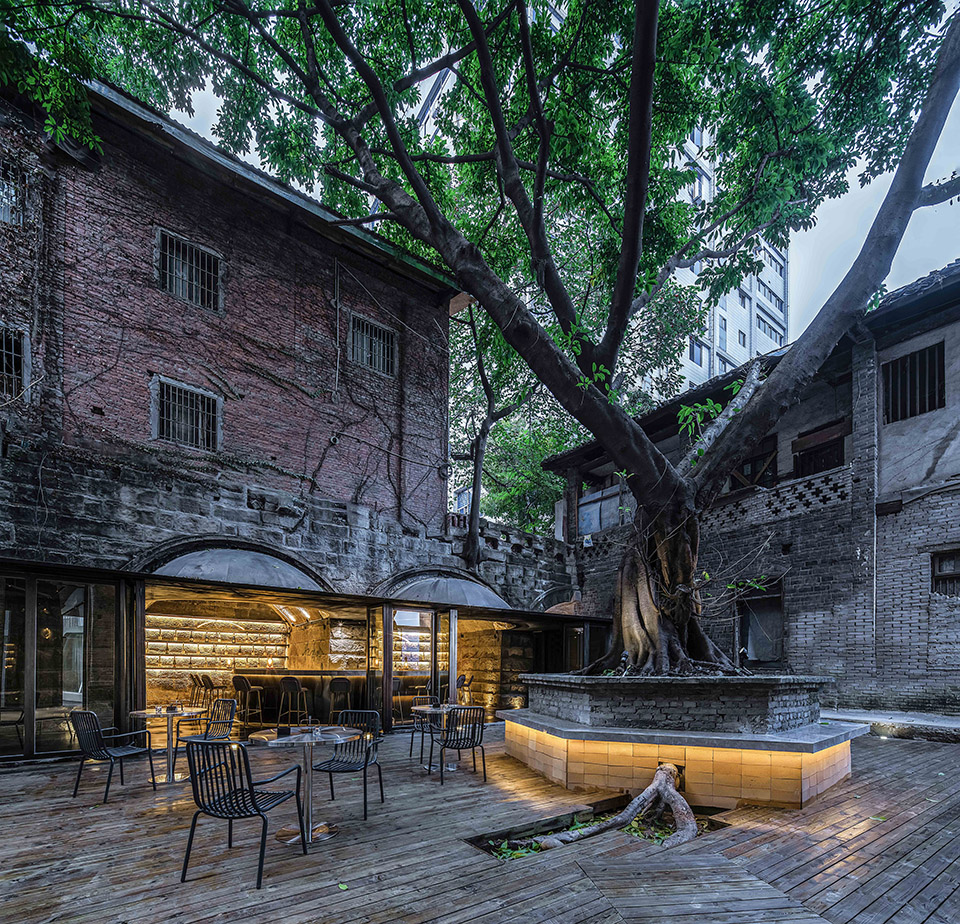
“Chongqing is a city full of air-raid shelters… When the hot pot is combined with the air-raid shelter, the biggest feature of Chongqing would be created…” The movie “Hot Pot Hero” has portrayed the spectacle-style dining space of “air-raid shelter hot pot”. During the Anti-Japanese War, Chongqing military and civilians excavated the world’s largest air defense engineering network, covering an area of more than 1.5 million square meters. According to the statistical archives of the Air Defense Command, in 1937, there were 54 air defense and shelter facilities in Chongqing, which could accommodate 7208 people, accounting for only 1% of the registered population in Chongqing. Since 1938, Japan officially bombed the urban area of Chongqing, and the National Government has accelerated the construction of air defense works. By 1942, the number of air-raid shelters in Chongqing had reached 1,603, with an average of 178 air-raid shelters per square kilometer, which could accommodate all citizens.
▼庭院及入口,the courtyard and the entrance

如今,山城巍然、洞口森森,但硝烟已散。重庆独特的“防空洞文化”开始融入百姓生活:在没有空调的年代,常年保持4℃的防空洞先是成了纳凉和幽会的圣地;随后,被当成异类的摇滚青年们也来了,带着乐器,吼着名副其实的“地下摇滚”;进入21世纪,市政府在修建轨道交通的时候,充分利用了原来的防空洞系统,并随之带动了更多公共功能的植入,有的被改造成了地下商场、火锅店、博物馆… 而那些小块头的则被改成了五金店、小卖部、社区纳凉点… 截止2019年,重庆主城区人防工程开发利用率已达到了91%。
Today, the mountain city and bomb shelters remain, but the fighting is over. Chongqing’s unique “air-raid culture” began to integrate into the people’s life: in the era of no air-conditioning, the 4°C air-raid shelter was sanctuaries for the cool and retreat; then, the rock-and-roll youths also came with musical instruments; entering the 21st century, the city government made full use of the original air-raid system when building rail transit, and then led to the implantation of more public functions. The air-raid shelters were transformed into underground shopping malls, hot pot restaurants, museums… while those small ones have been changed into hardware stores, canteens, community cool spots… By 2019, the utilization rate of civil air defense projects in Chongqing’s main urban area has reached 91%.
▼室内概览,interior overview

本项目是由原重庆市印制一厂内的防空洞改造的酒吧。重庆有两座由老厂区改造的网红文创园:枇杷山的印制一厂与鹅岭的印制二厂,这对姊妹厂修建于上世纪30年代,跟印钞票的二厂不同,一厂有着被灰尘覆盖的书卷气质,它曾经承担了重庆乃至川东片区出版课本、图书和期刊的任务。一厂位于一条次干道“枇杷山后街”的尽端,厂区共八栋建筑顺着山势围合出三组院落。第一进最大的院子是文创园的停车场,周围的多层老厂房中已进驻了各类独立艺术工作室,斑驳的红砖墙点缀以炫目的彩色玻璃与黑钢,肃穆的革命标语搭配上新潮的涂鸦和招牌,这是典型改造项目的氛围,由老建筑与“新材料”调配出的熟悉味道。沿着西端的山路拾级而上,是由两栋老职工宿舍围合出的第二进狭长形院落,它们整体被改造成了造型华丽的江景酒店“山鬼”,它对自己的历史身份并无太多留恋,在这个略显破败的老街区中骄傲的展示着自己超群的“颜值”。酒店的北侧就是本项目的所在地:由老职工宿舍、防空洞、以及川军名将郭勋祺的公馆围合出的第三进楔形院落,现已被作为山鬼酒店的后院重新开发,改造成一个带有酒吧的户外休闲场所。
The first and largest yard is the parking. The surrounding multi-story old factories have been stationed by various independent art studios. The mottled red brick walls are decorated with dazzling glass and black steel. The solemn revolutionary slogan paired with trendy graffiti and signboards, this is the atmosphere of a typical renovation project. Along the mountain road, it is the second narrow courtyard enclosed by two old staff quarters. They have been transformed into a gorgeous river view hotel named “Mountain Ghost”, which has not much nostalgia for its own historical identity. “He” proudly displays “his” superior “Face Score” in this slightly dilapidated old block. The north side of the hotel is the location of the project: the third courtyard enclosed by the old staff quarters, bomb shelter and former residences of the Sichuan military star Guo Xunqi. It has been redeveloped as a backyard of the “Mountain Ghost Hotel”. This project is a bar transformed from the original air-raid shelter in the 1st Printing factory in Chongqing. Chongqing has two Creative Parks transformed from the old factory area: the 1st printing factory in loquat mountain and the 2nd printing factory in ELing mountain. These sister factorys were built in the 1930s, unlike the 2nd printing factory that print the banknotes. The 1st factory has the temperament of books covered by dust. It once assumed the task of publishing textbooks and periodicals of the whole eastern part of Sichuan. The factory is located at the end of the Loquat Mountain Back Street. A total of eight buildings in the factory area are combined with three courtyards along the mountain.
▼场地概况,site conditions

院子东侧是建于1934年的文物保护建筑郭勋祺公馆;南侧的老职工宿舍一楼已被改造为山鬼酒店的餐厅,同时也是进入后院的主入口;北侧是三个联排的小型防空洞,砖石结构的连续拱,其中最东边的一个被郭公馆挡住了大半个入口。院子中央是一株老槐树,树冠撑满了整个院子。面对这样一个面积不大,且中央被巨大树池所占据的院子,结合防空洞贴着院子北端布置酒吧几乎是唯一的选择,既能够充分利用庭院中最具特点的元素,也能面向酒店餐厅形成最佳的观赏面。
▼场地原状,existing conditions of the site
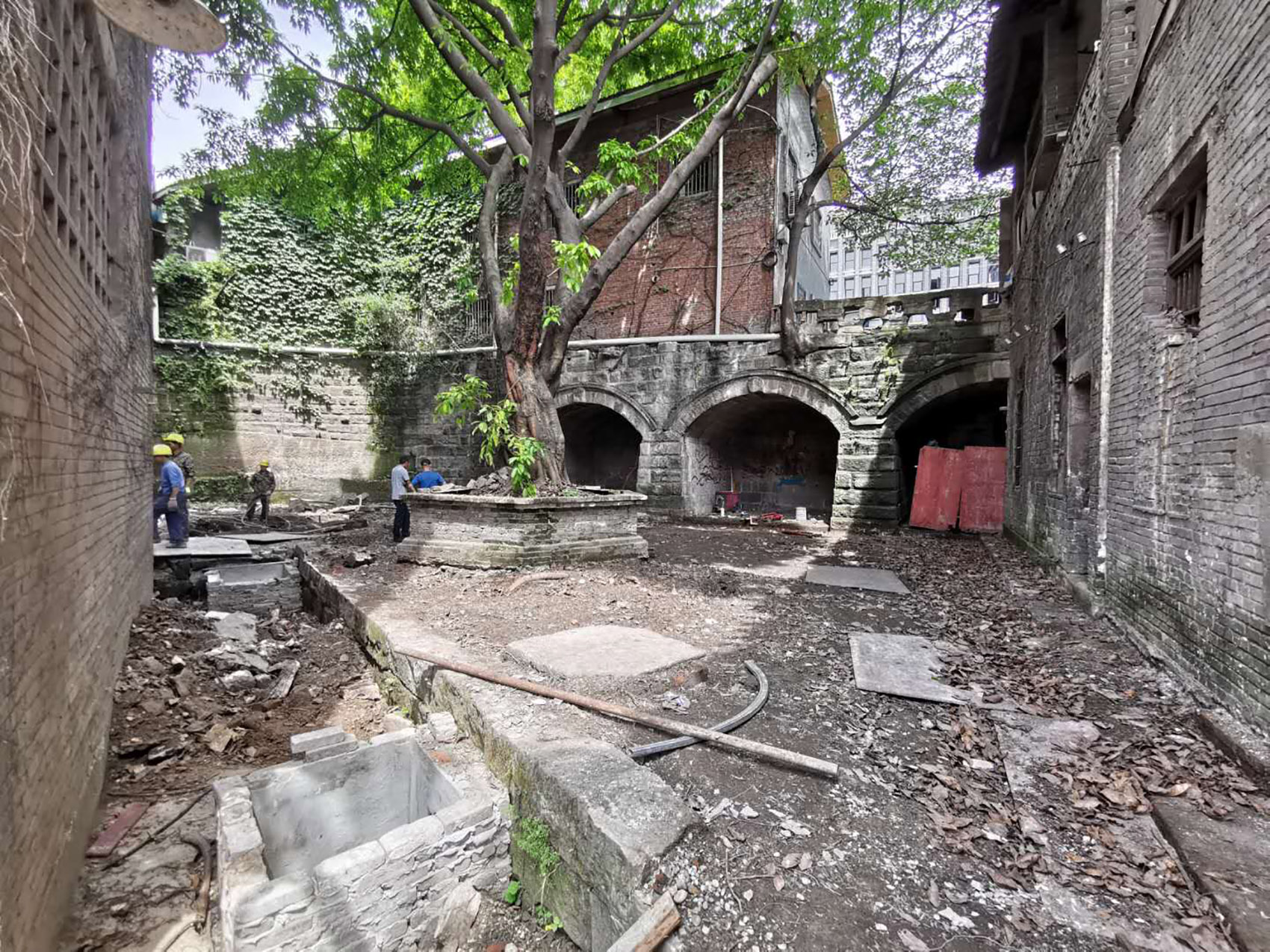
On the east side of the yard is the former residences of the Sichuan military star Guo Xunqi, which is a cultural relic-protected building built in 1934. The first floor of the old staff quarters on the south side has been transformed into the restaurant of the “Mountain Ghost Hotel”, which is also the main entrance to the backyard. The north side is three small air-raid shelters, but the easternmost one was blocked by the former residences of the Guo Xunqi. In the center of the yard is an old banyan tree with a canopy that fills the entire yard. Faced with such a small area, and the center is occupied by a huge tree pond, put the bar at the north end of the yard is almost the only choice, to make full use of the most characteristic elements in the courtyard.
▼项目轴测图,axon
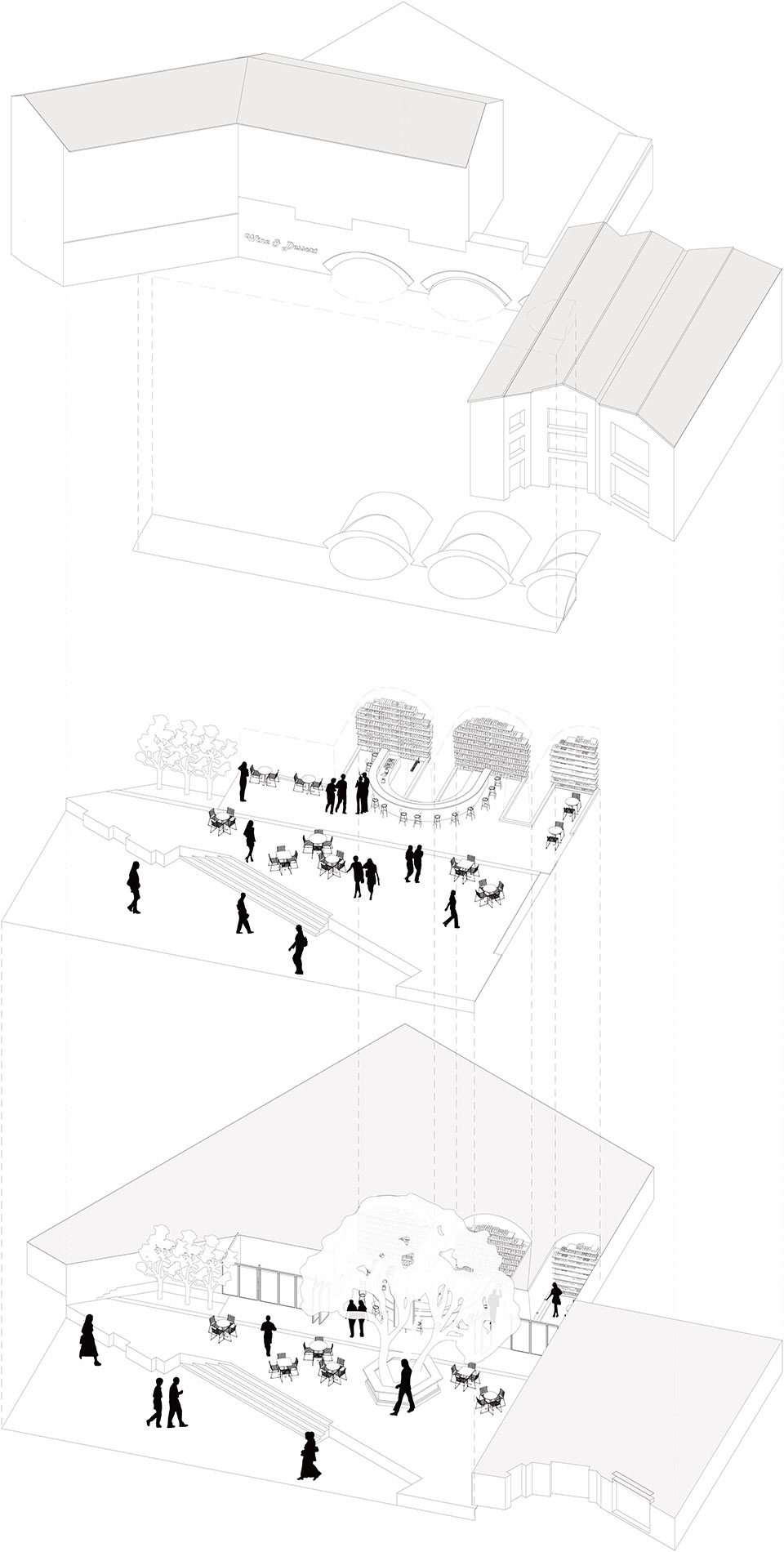
▼改造后的场地,site after renovation
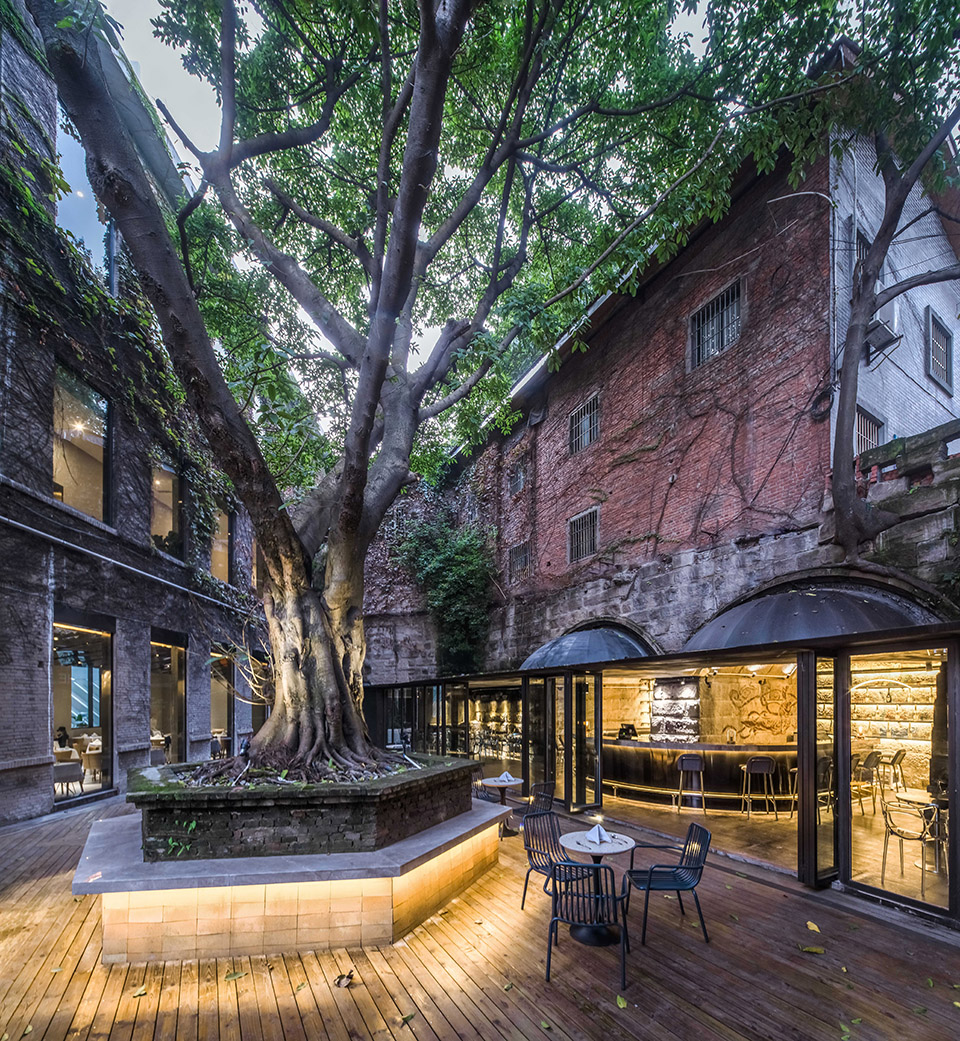
三个防空洞互不联通,每个占地面积约为4m*4m,拱脚距地面仅2.1m,如何在其基础上发展出适合酒吧的空间是该设计的重点。首先增加了一条宽2.5米的前廊将三个防空洞串联起来,但这样的平面更像是一条走廊连接的三个包间,而非酒吧。为了消解这种状态,我们利用半圆形的吧台将其中两个防空洞进行了空间上的“桥接”,让酒吧平面变为以一堵老石墙为轴心的放射性空间,从而强化其整体感,而另一个入口被挡住大半的防空洞则被用作储藏空间(酒窖)。但这样的布局导致操作空间更加局促,因此酒架无法按照常规放在吧台的背后,而是被设置在防空洞的尽端,形成整个酒吧的背景墙。
▼体量生成图,conceptual diagram

The three air-raid shelters are not connected to each other. Each floor space is about 4m*4m, and the arch is only 2.1m away from the ground. How to develop a space suitable for the bar is the focus of the design. Firstly, a 2.5-meter-wide front porch was added to connect the three air-raid shelters, but the plan is more like a series of cubicles connected by a corridor. To eliminate this state, we use a semi-circular desk to spatially “bridge” two of the air-raid holes, to make the bar plan become a radioactive space centered on an old stone wall, thus strengthening the overall sense. However, such a layout leads to smaller operation space, so the wine rack cannot be placed behind the bar as usual, but is placed at the end of the bomb shelter to form the background wall of the bar.
▼一条宽2.5米的前廊将三个防空洞串联起来,a 2.5-meter-wide front porch was added to connect the three air-raid shelters
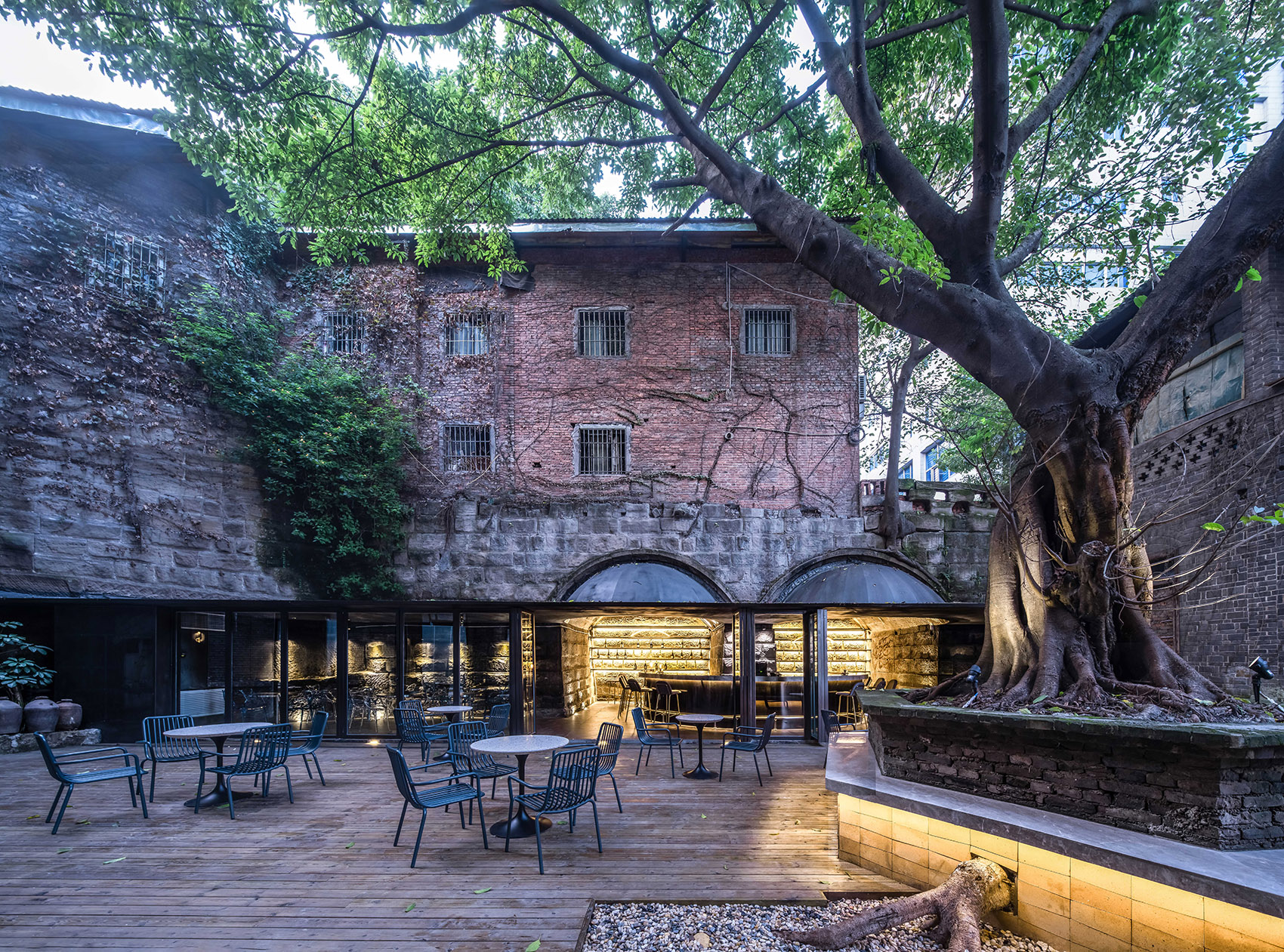
▼中央被巨大树池所占据的院子,an old banyan tree with a canopy that fills the entire yard
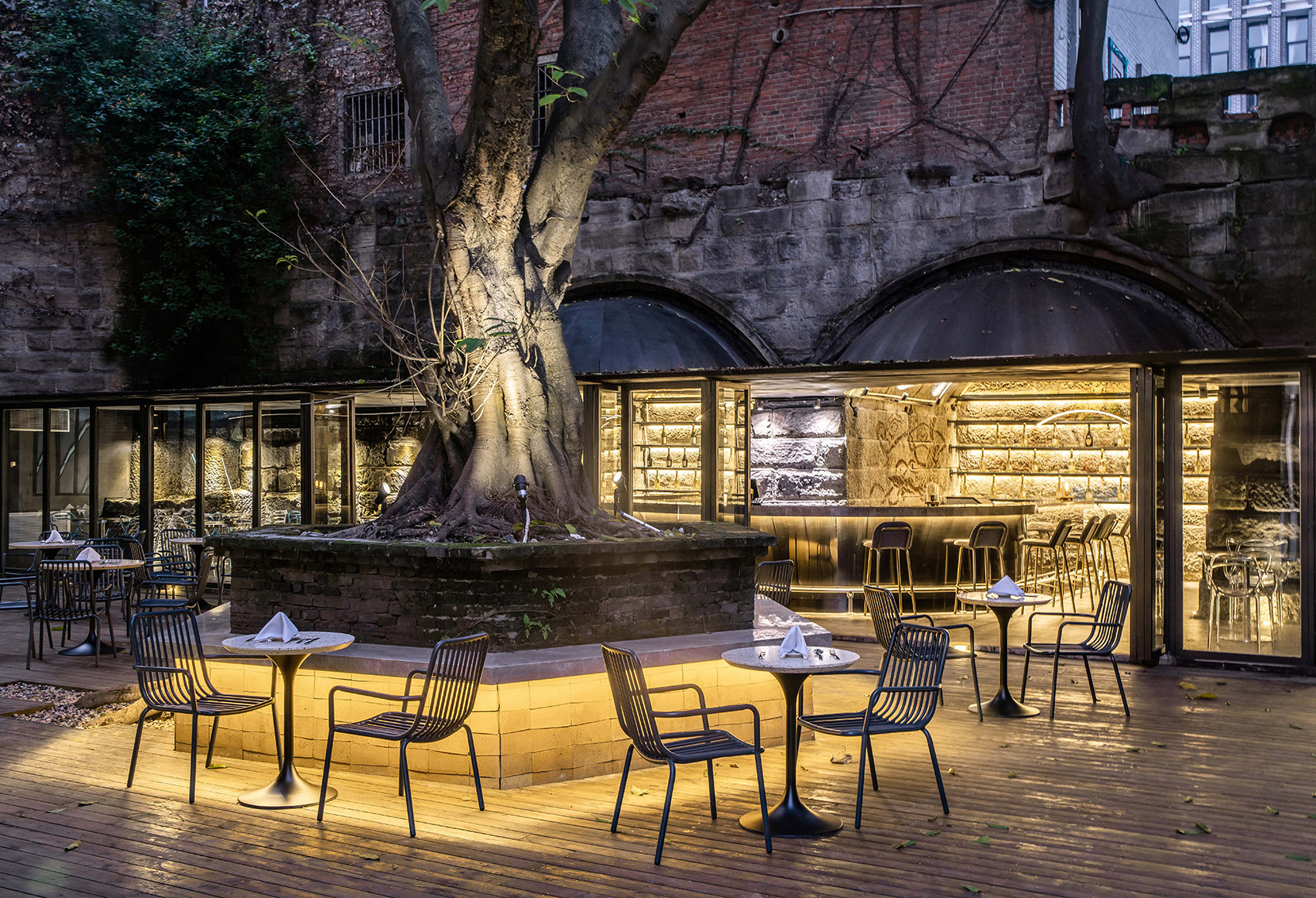
▼细部,details
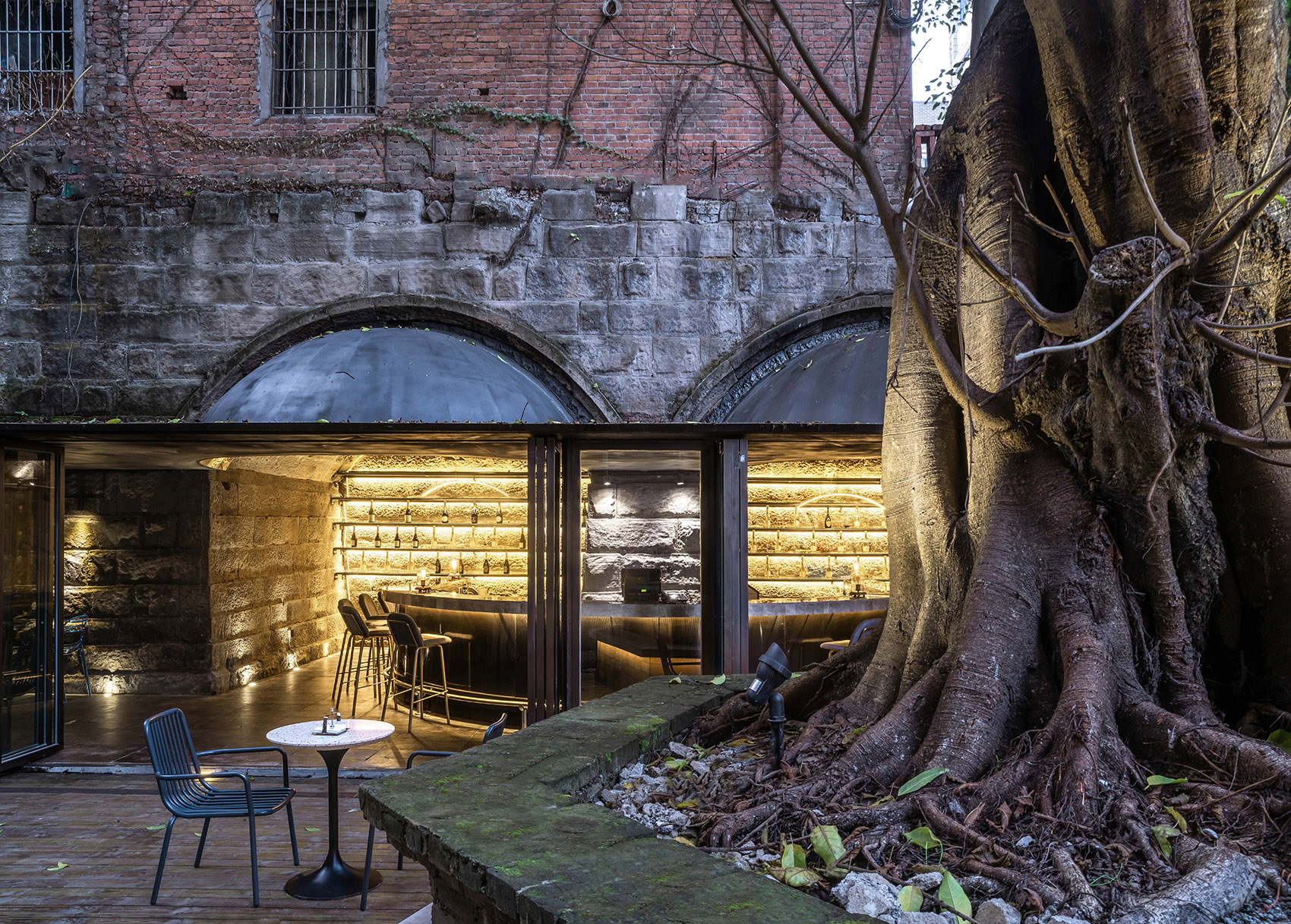
为了衔接防空洞的拱顶与新增前廊的平顶,我们将前廊高度控制在拱脚的位置,并在前廊屋顶上用1/4的球体来衔接防空洞的拱券,从而实现新旧部分在外部形态和室内空间上的自然过度。新增前廊部分除了主梁采用100mm*100mm的C型钢外,其余的檩条与柱子统一采用50mm*40mm方钢管(其中柱子由五根钢管焊接成十字柱),这是附近建材市场中唯一的小规格结构材料。屋顶顶板与底板均为5mm厚镀锌钢板,内衬保温层固定在檩条之间,外挂排水沟底部齐屋顶底板,并向外倾斜,保证檐口高度仅为35mm。折叠推拉门的轨道被藏于C型钢主梁之中,保证室内外屋顶底面的连续性不被任何构件打断。而衔接平屋顶与拱顶的球体也在室内被忠实的呈现,但内壁材料更换成了镜面不锈钢,它将背后酒架的残影扭曲、揉碎后重新投射出来,让灯红酒绿的室内氛围愈发迷离和虚幻。
▼防空洞剖面图,section
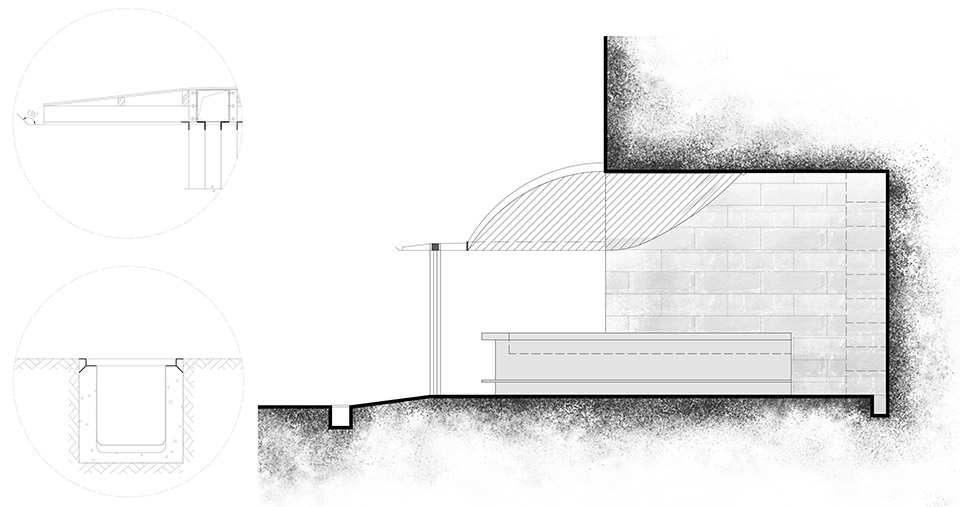
In order to connect the vaulted roof to the flat roof of the new front porch, we control the height of the front porch at the arched foot and use a 1/4 sphere to connect the wall, so as to realize the natural transition between the old and new parts in the external form and internal space, respectively. The main beam adopts 100mm*100mm C-shaped steel, and the other beams and columns are uniformly made of 50mm*40mm square steel pipe (the column is welded by five steel pipes into a cross column), which is the only small scale structural material in the nearby building materials market. The roof and the bottom of the roof are both 5mm thick galvanized steel sheets. The external drainage ditch is tilted outwards to ensure that the height of the cornice is only 35mm. The track of the folding sliding door is hidden in the C-shaped main beam to ensure that the continuity of the indoor and outdoor roof bottom is not interrupted by any member. The spheres that connect the flat roof and the vault are also perfectly presented indoors, but the inner wall material is replaced with mirror stainless steel, It re-projects the distorted image of the wine rack, making the indoor atmosphere more and more blurred and illusory.
▼衔接平屋顶与拱顶的球体,the spheres that connect the flat roof and the vault
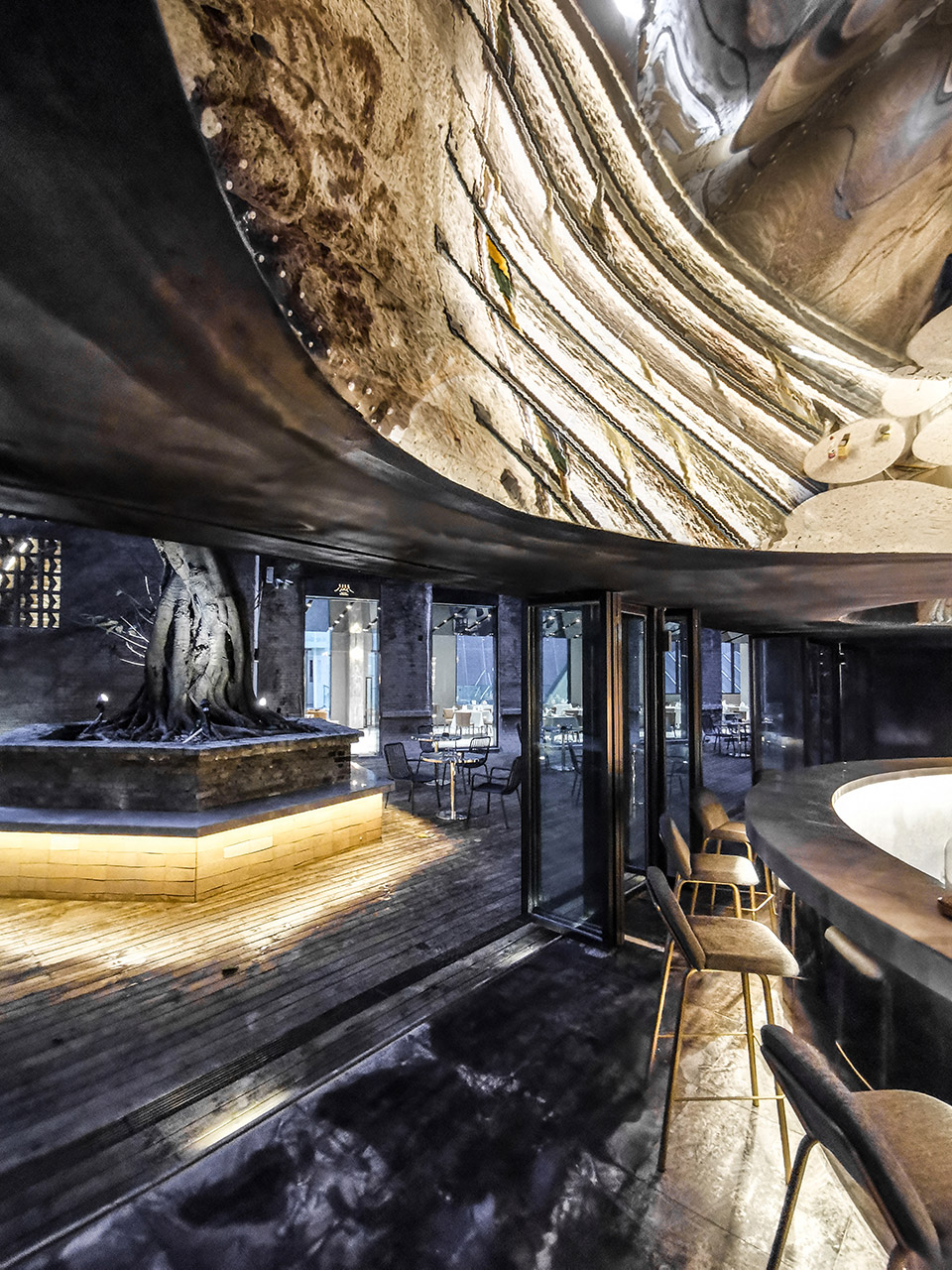
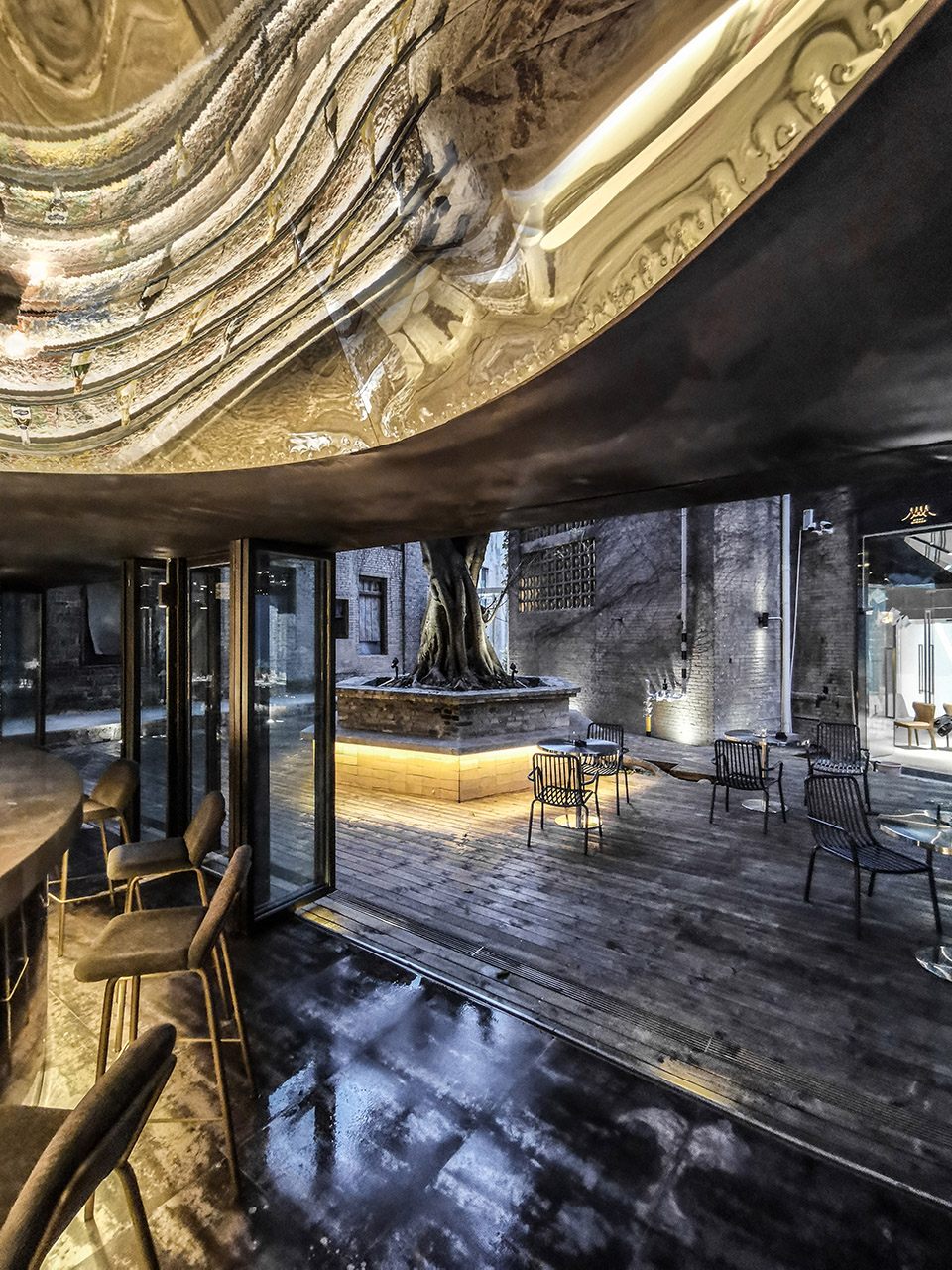
▼拱顶以及球体屋顶,the vault and the spherical roof
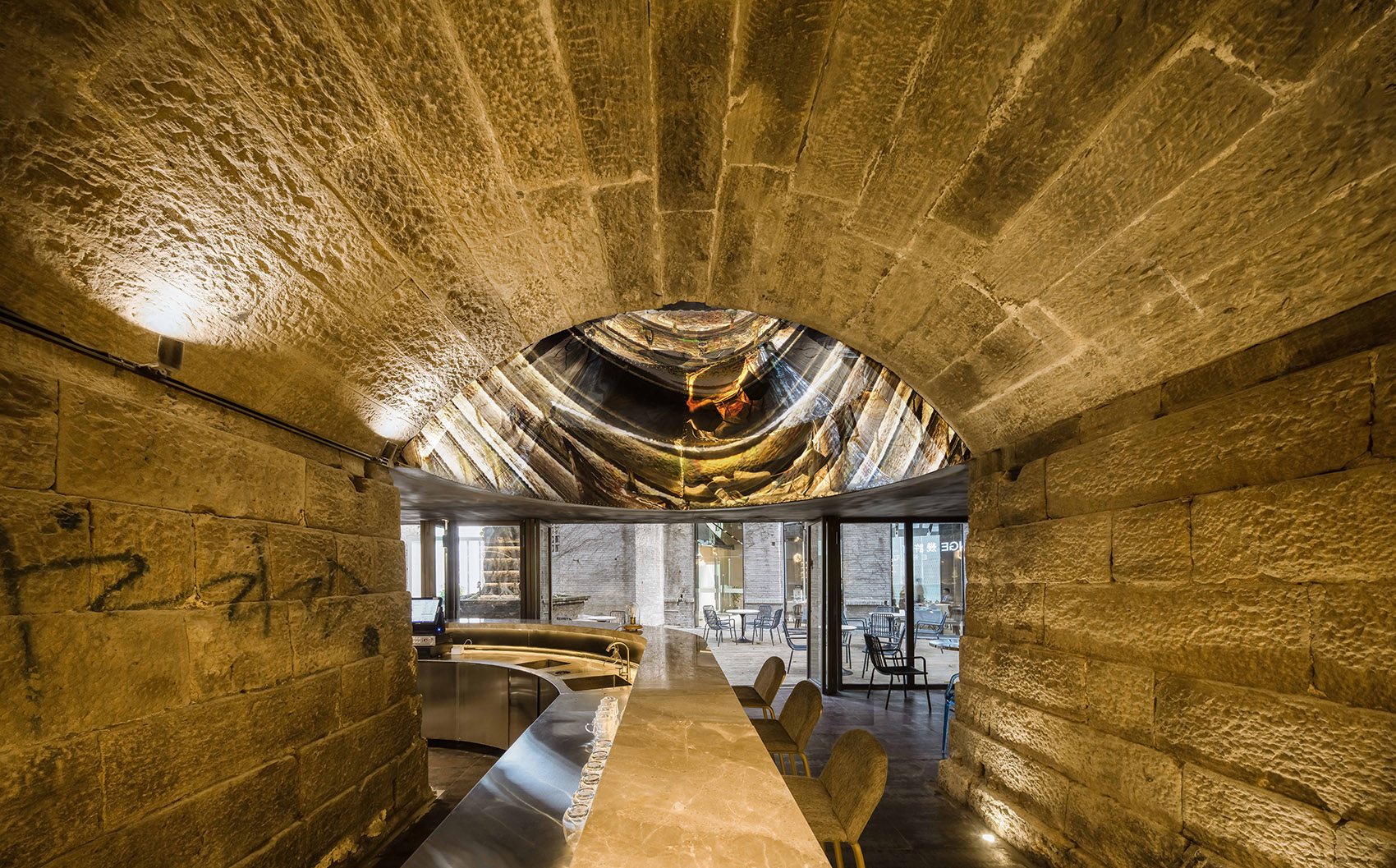
▼半圆形的吧台将其中两个防空洞进行了空间上的“桥接”,a semi-circular desk to spatially “bridge” two of the air-raid holes
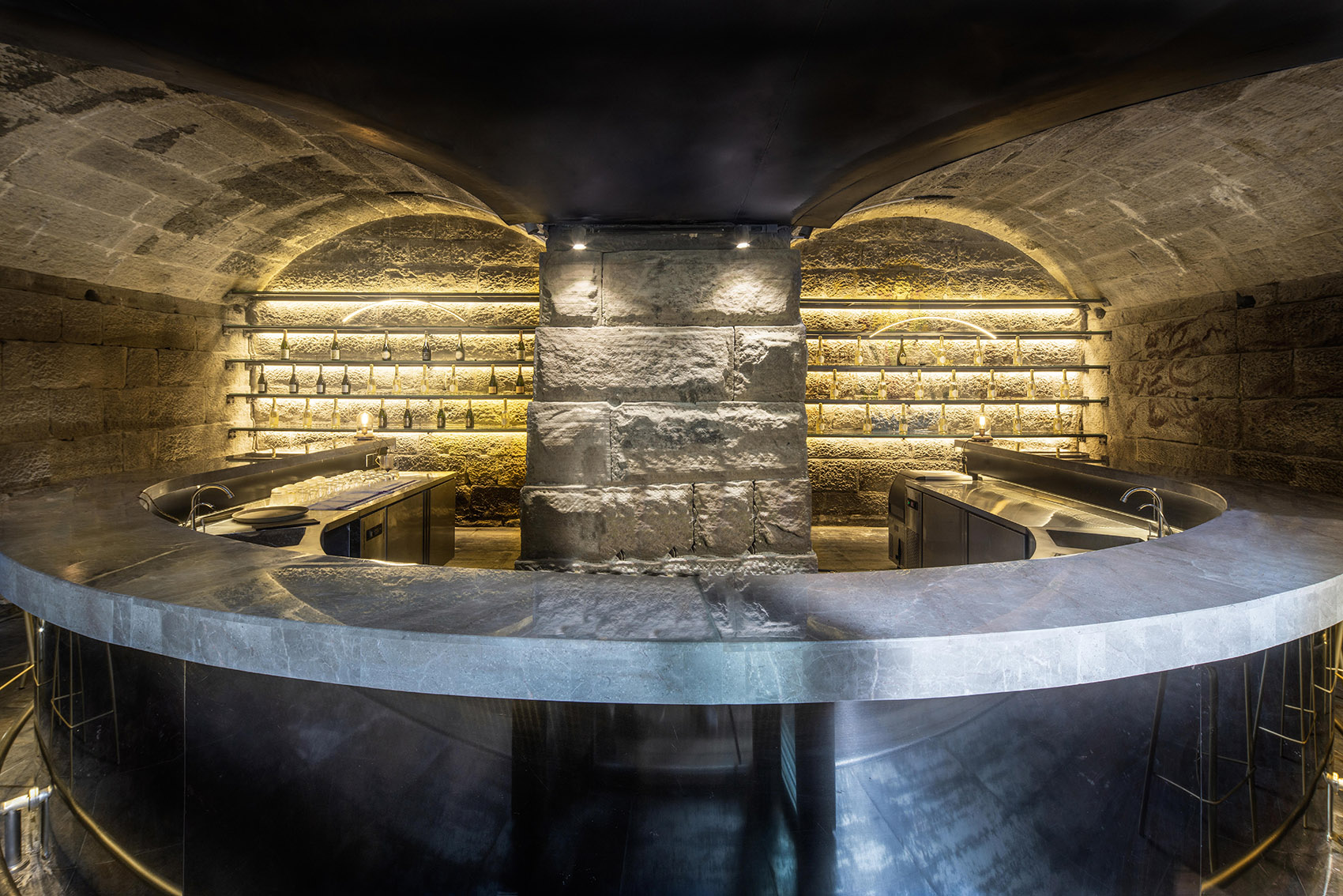
▼以一堵老石墙为轴心的放射性空间,a radioactive space centered on an old stone wall
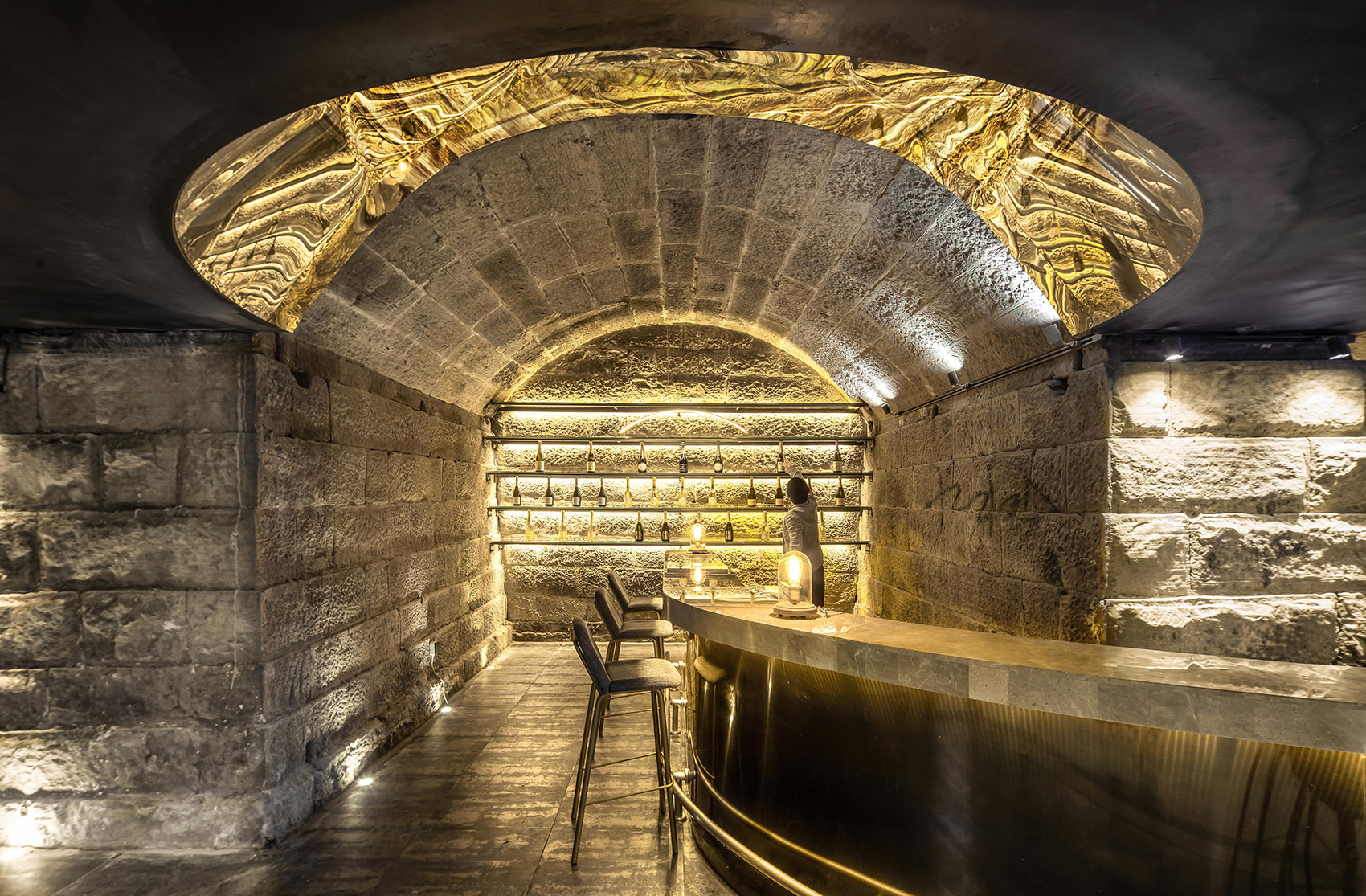
▼内壁材料更换成了镜面不锈钢,它将背后酒架的残影扭曲、揉碎后重新投射出来,the inner wall material is replaced with mirror stainless steel, which re-projects the distorted image of the wine rack
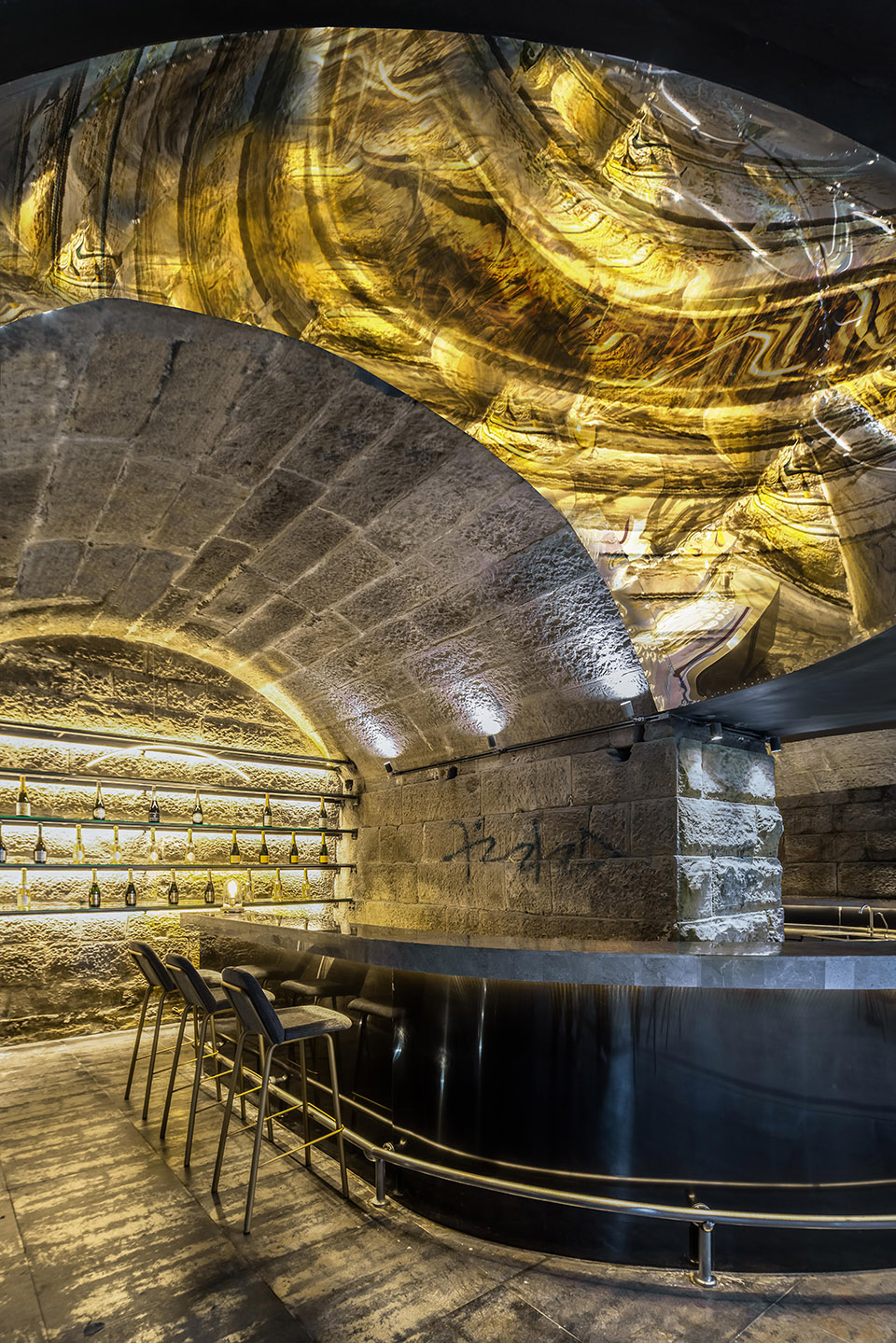
▼用餐区,dining area

▼平面图,floor plan

▼剖面图,section

